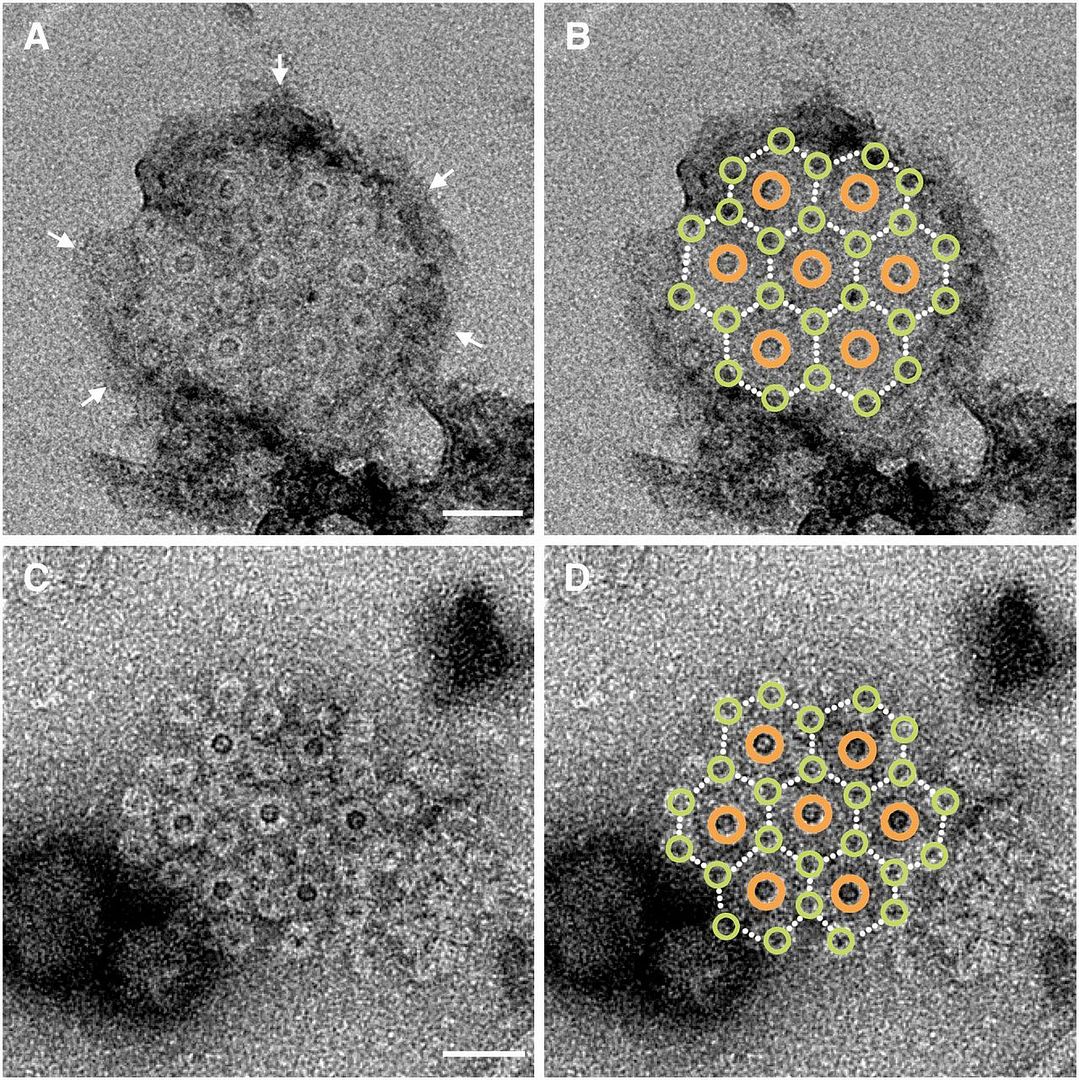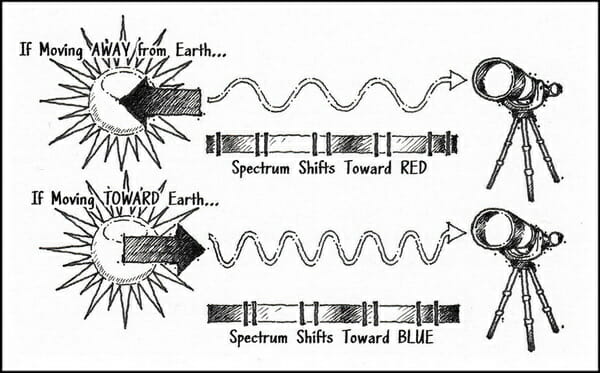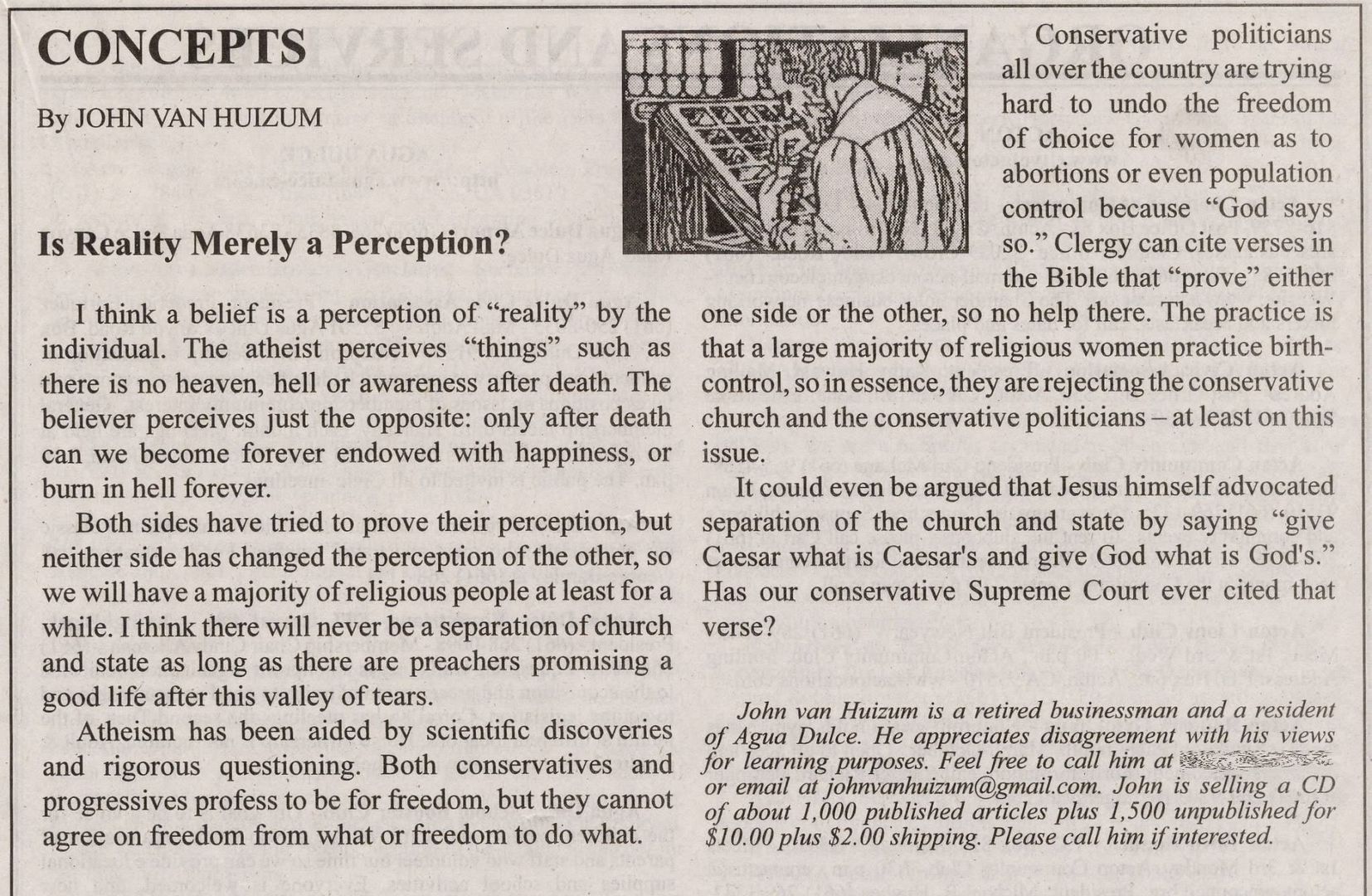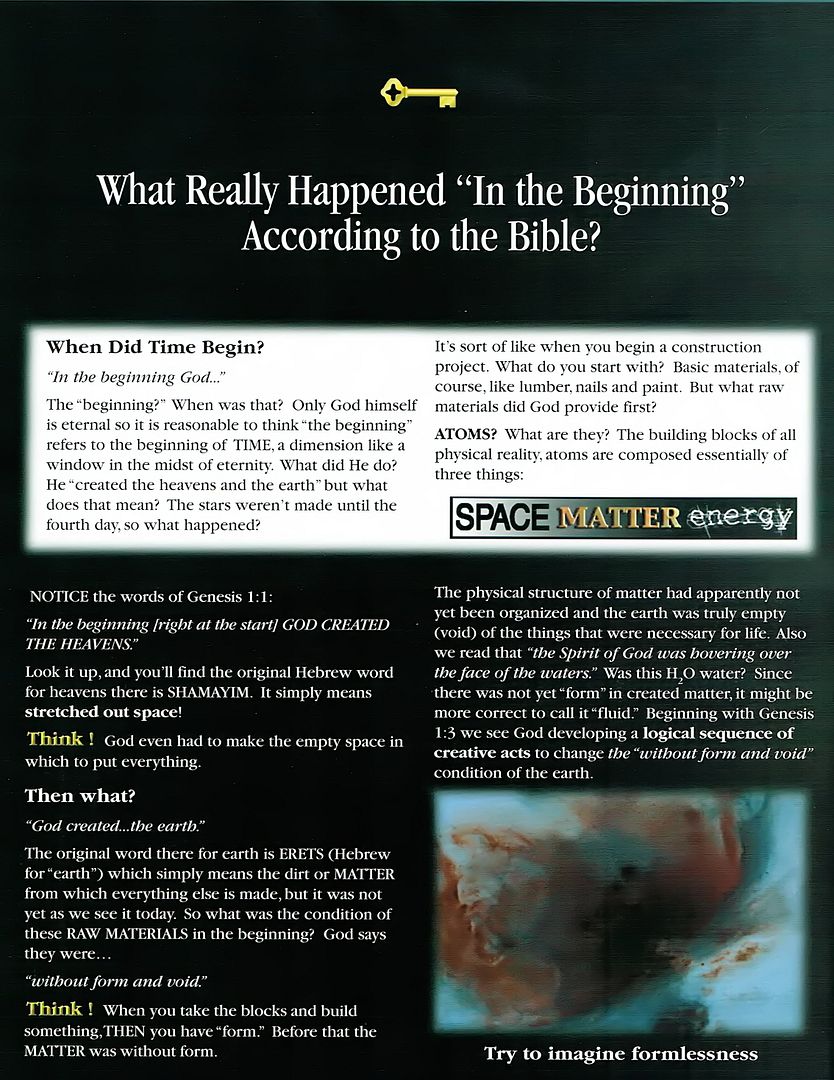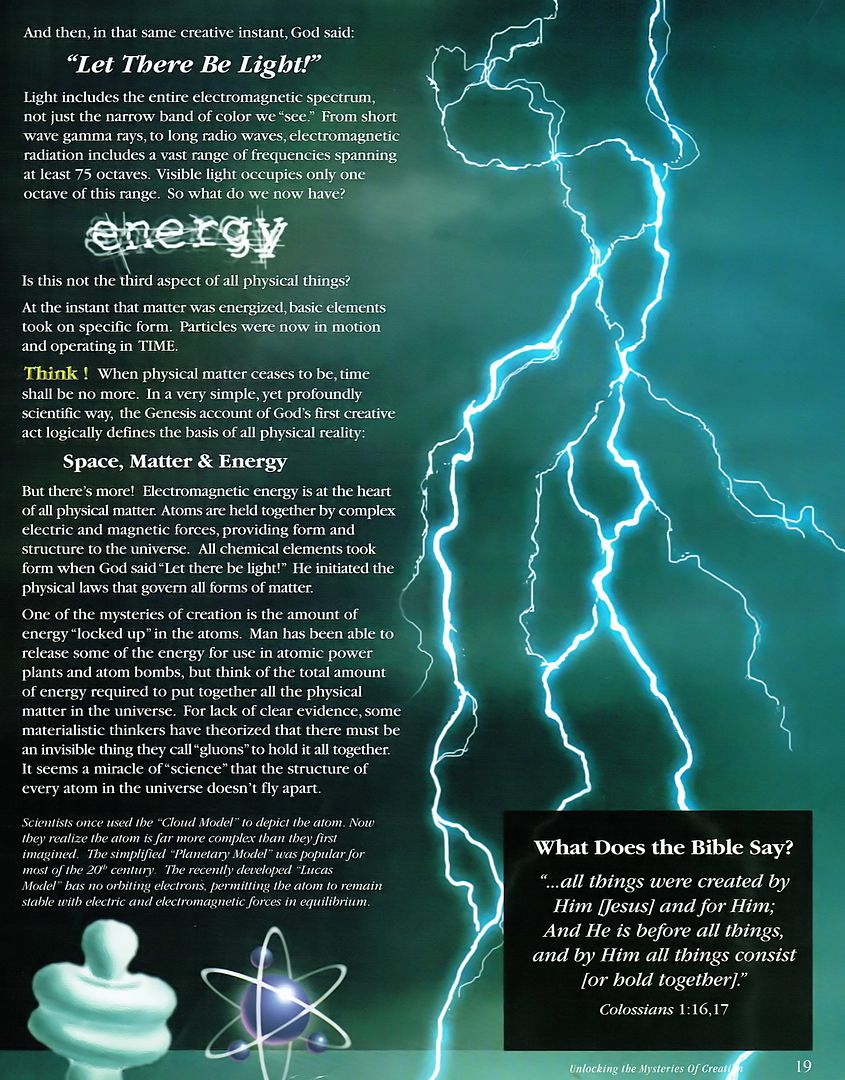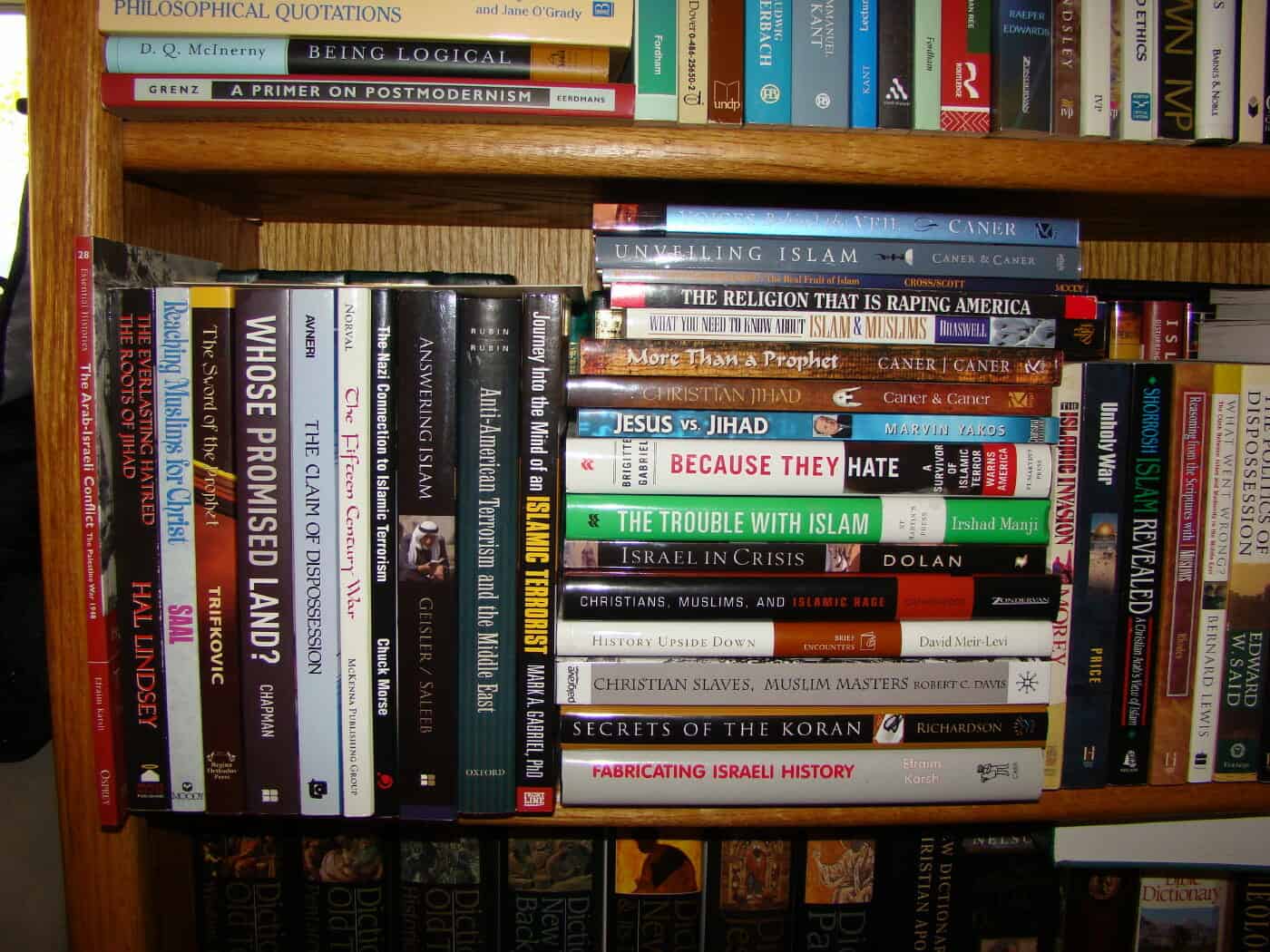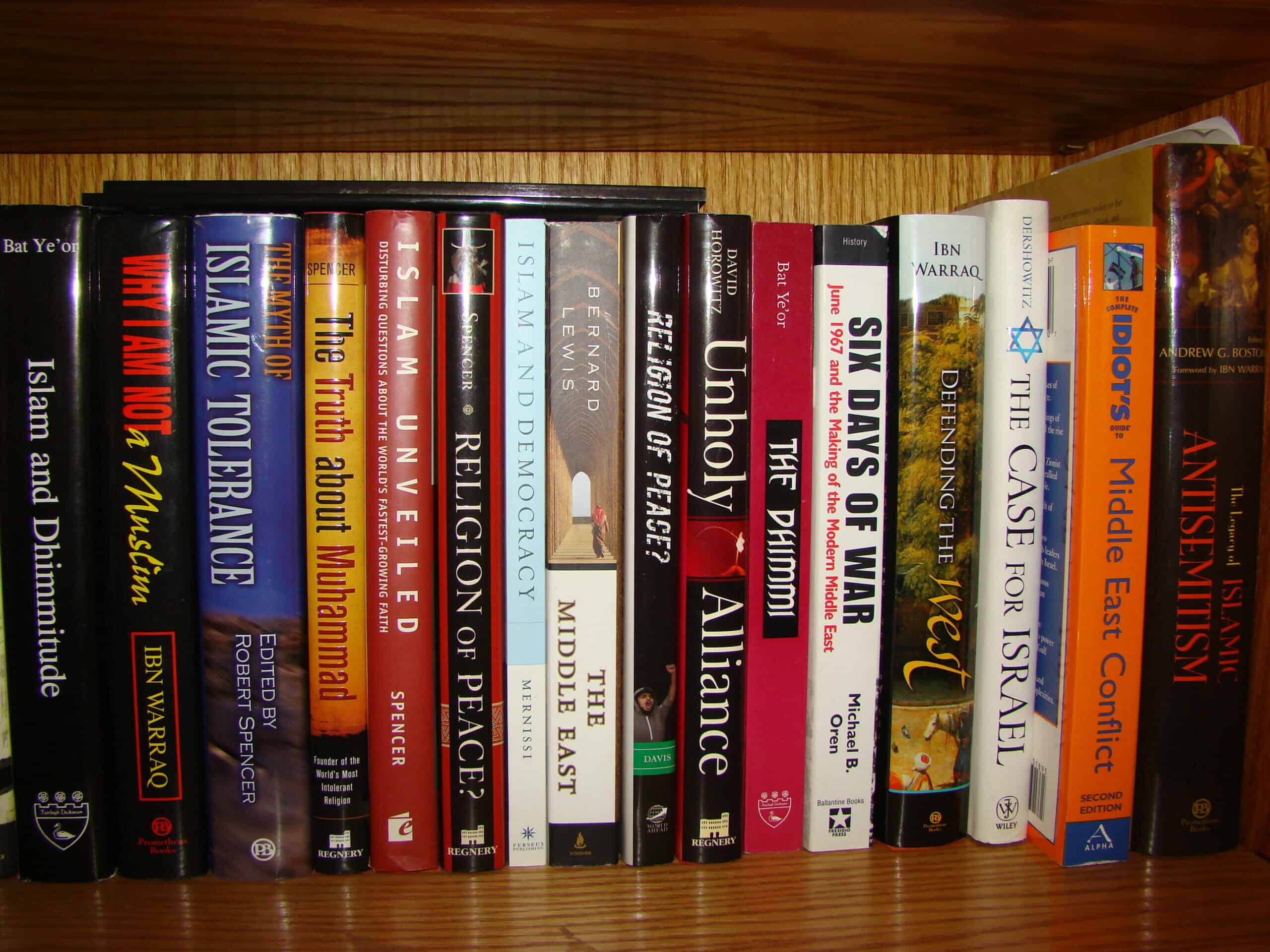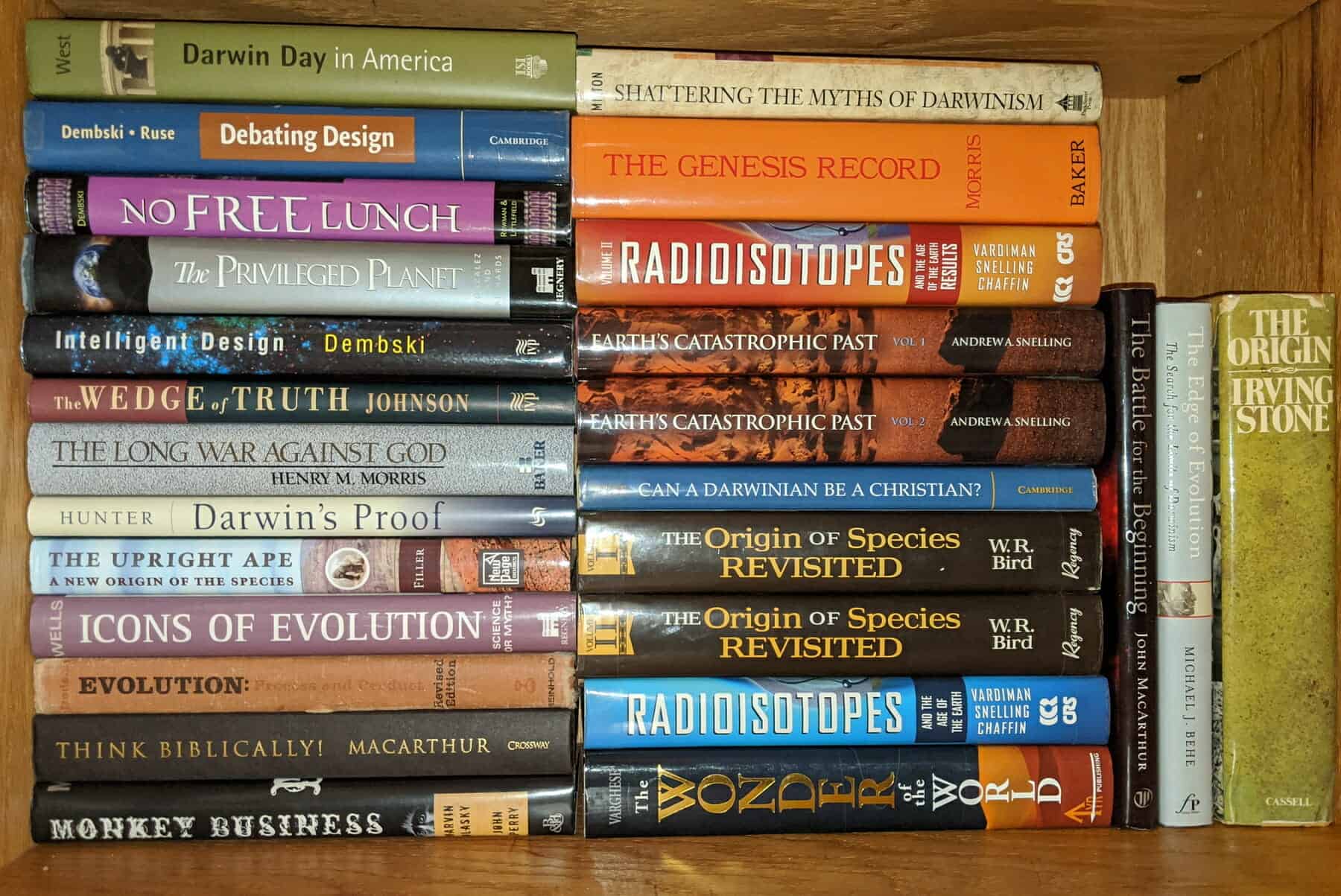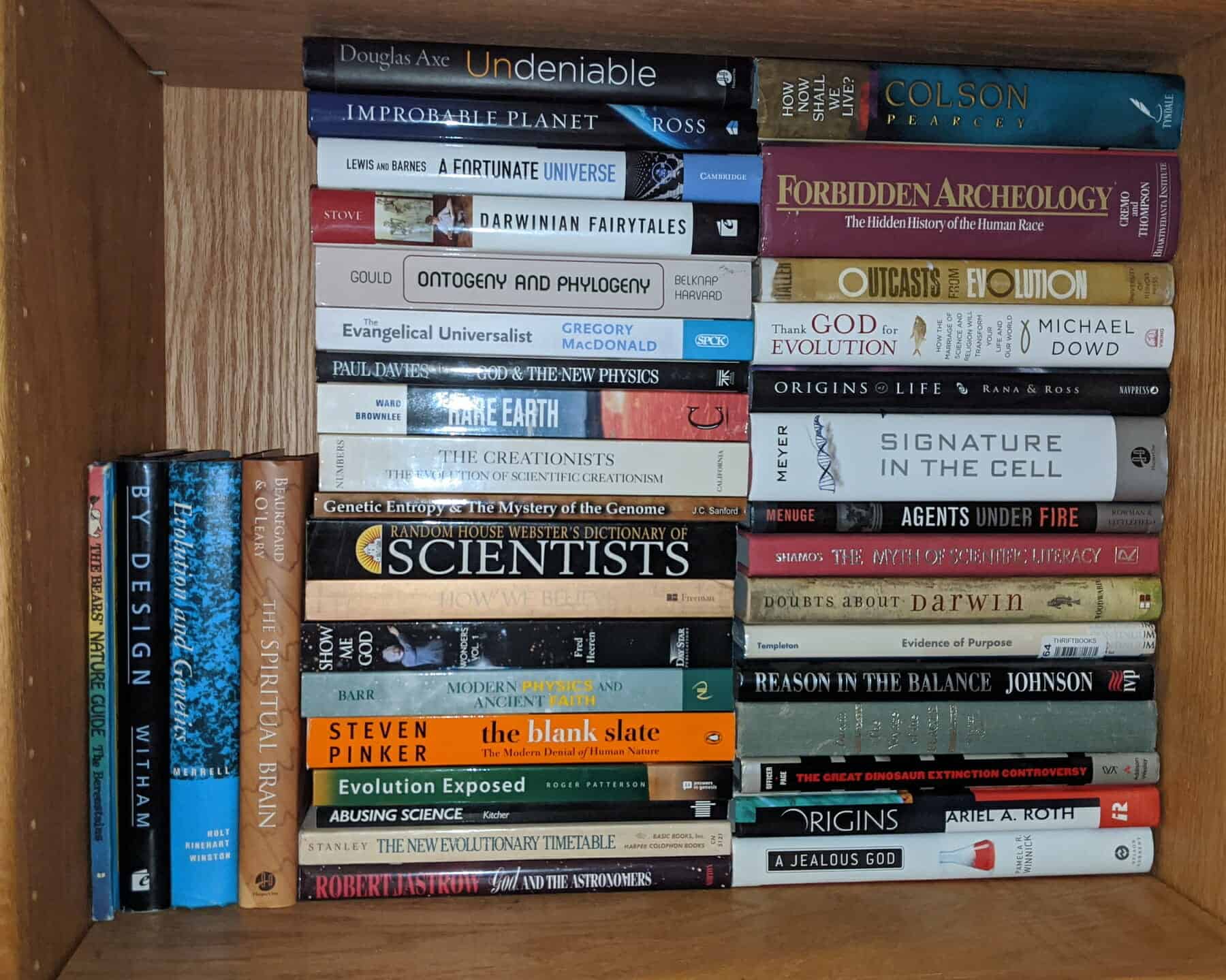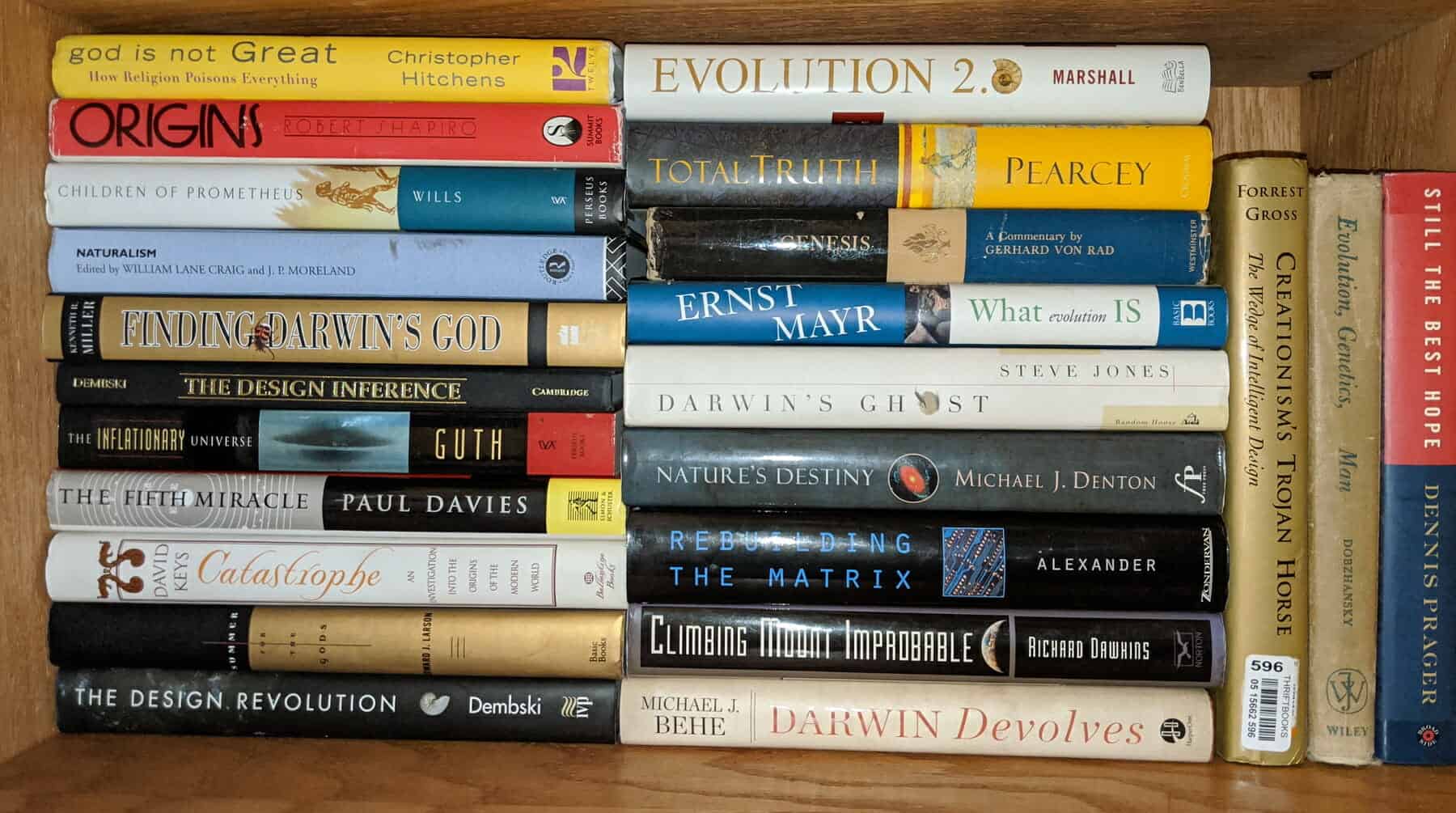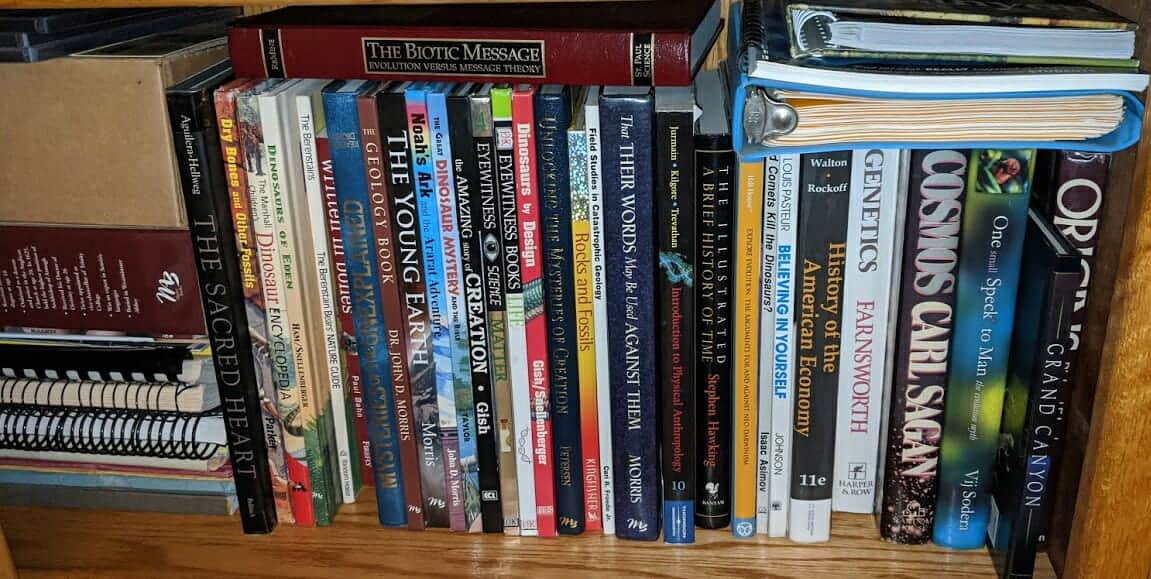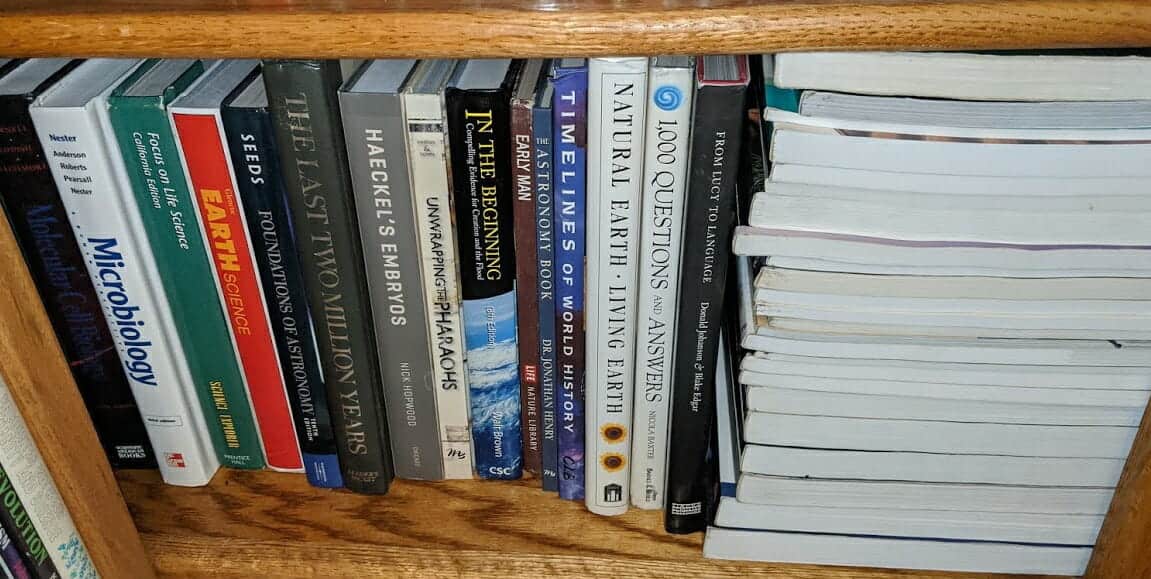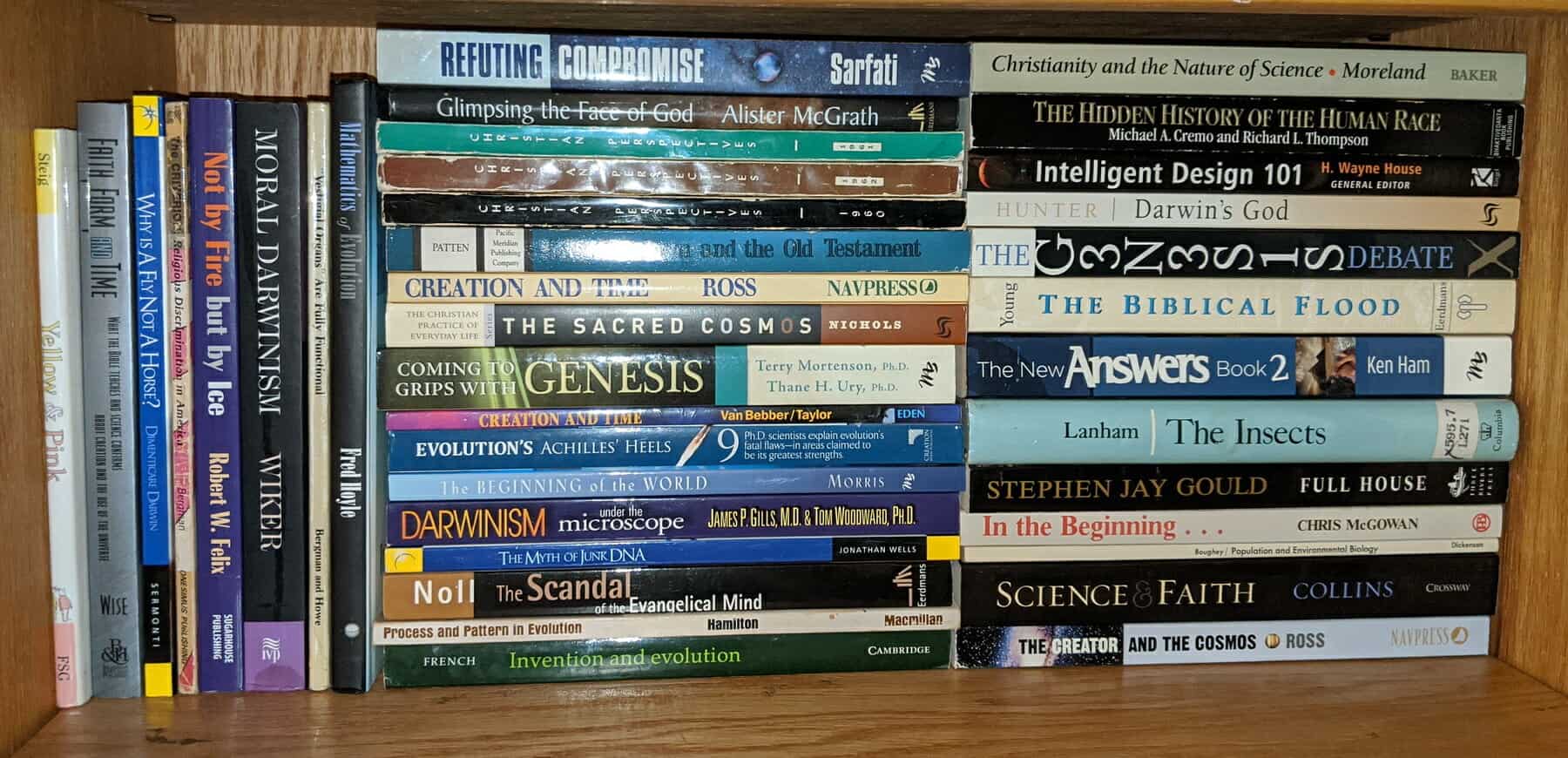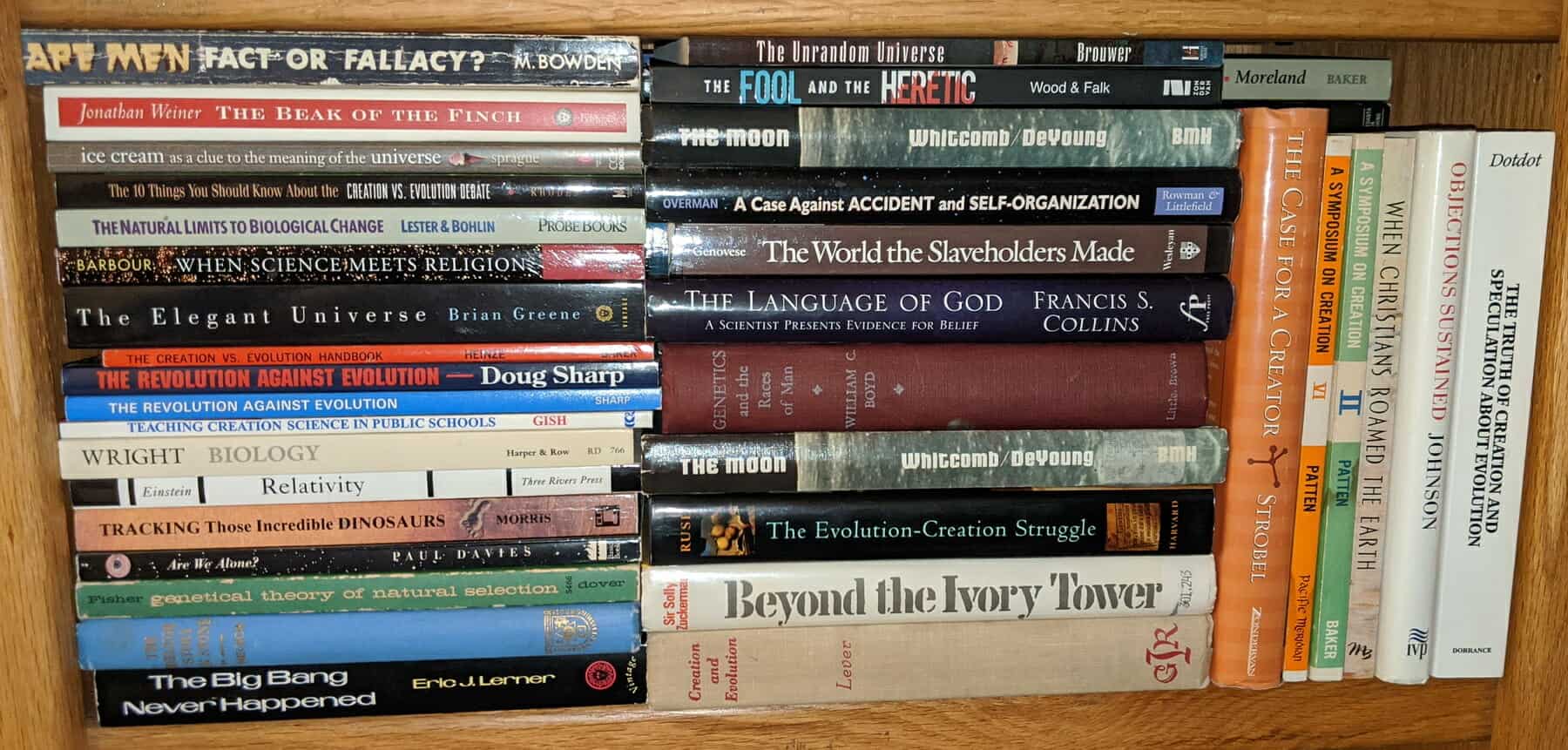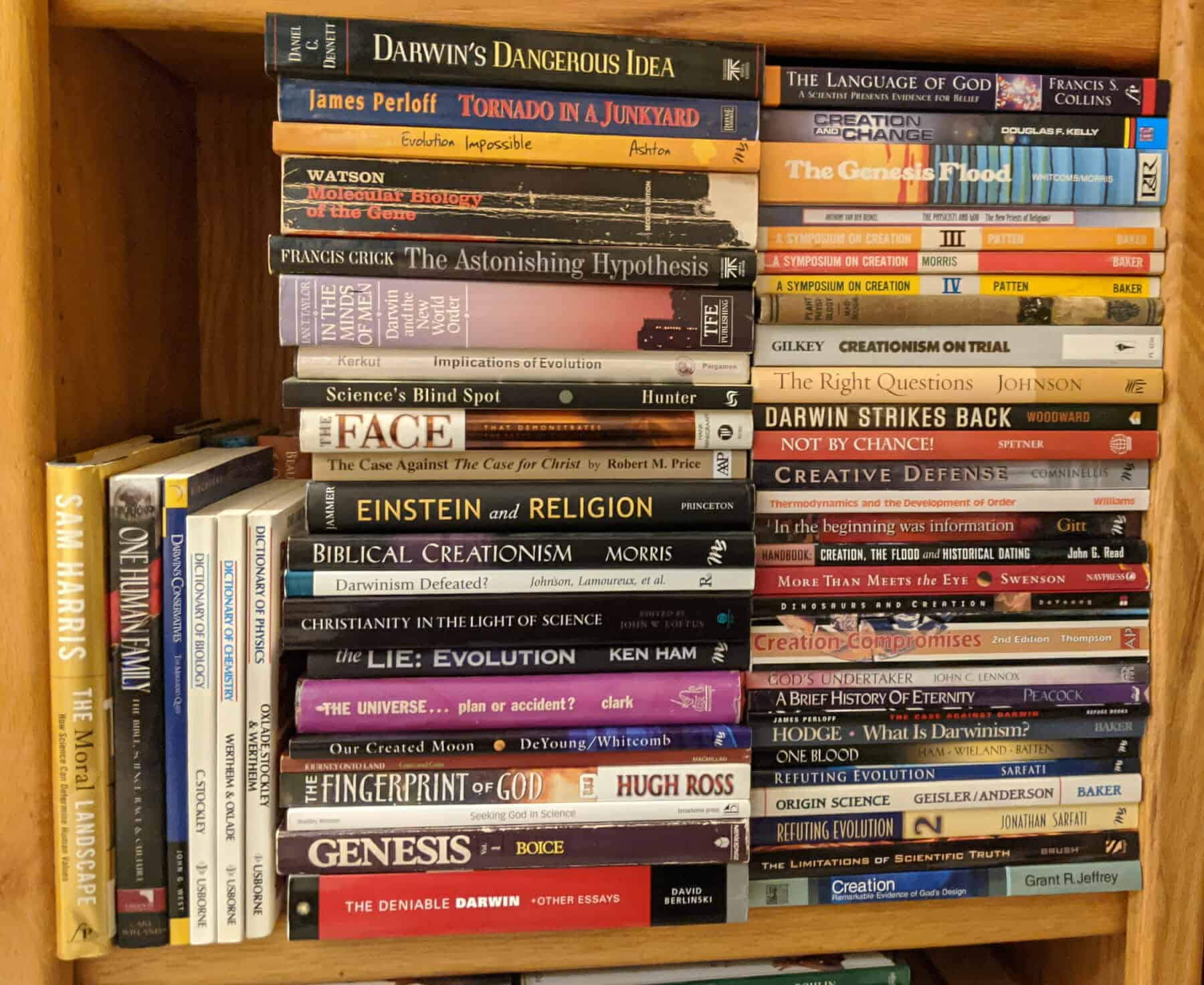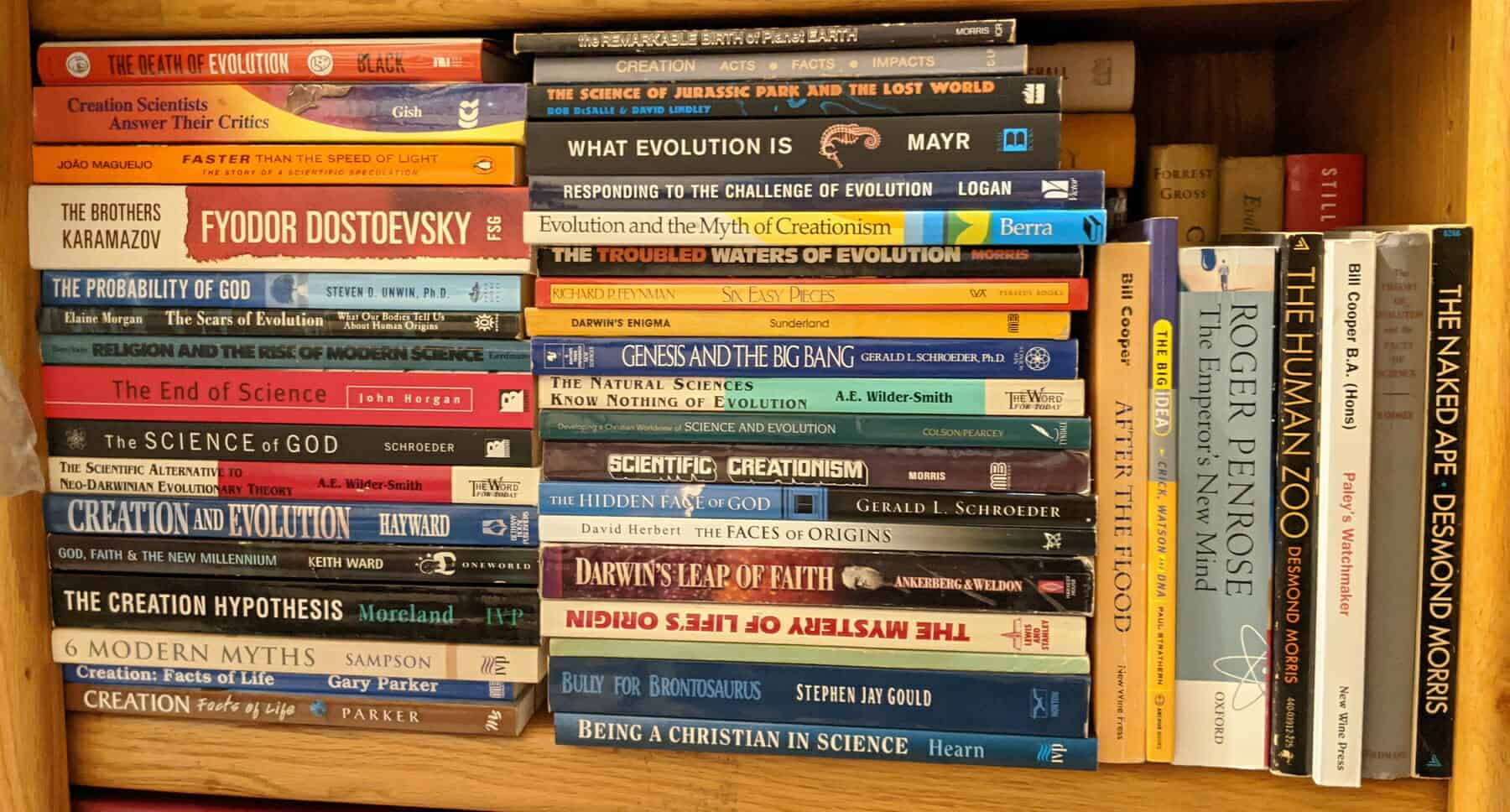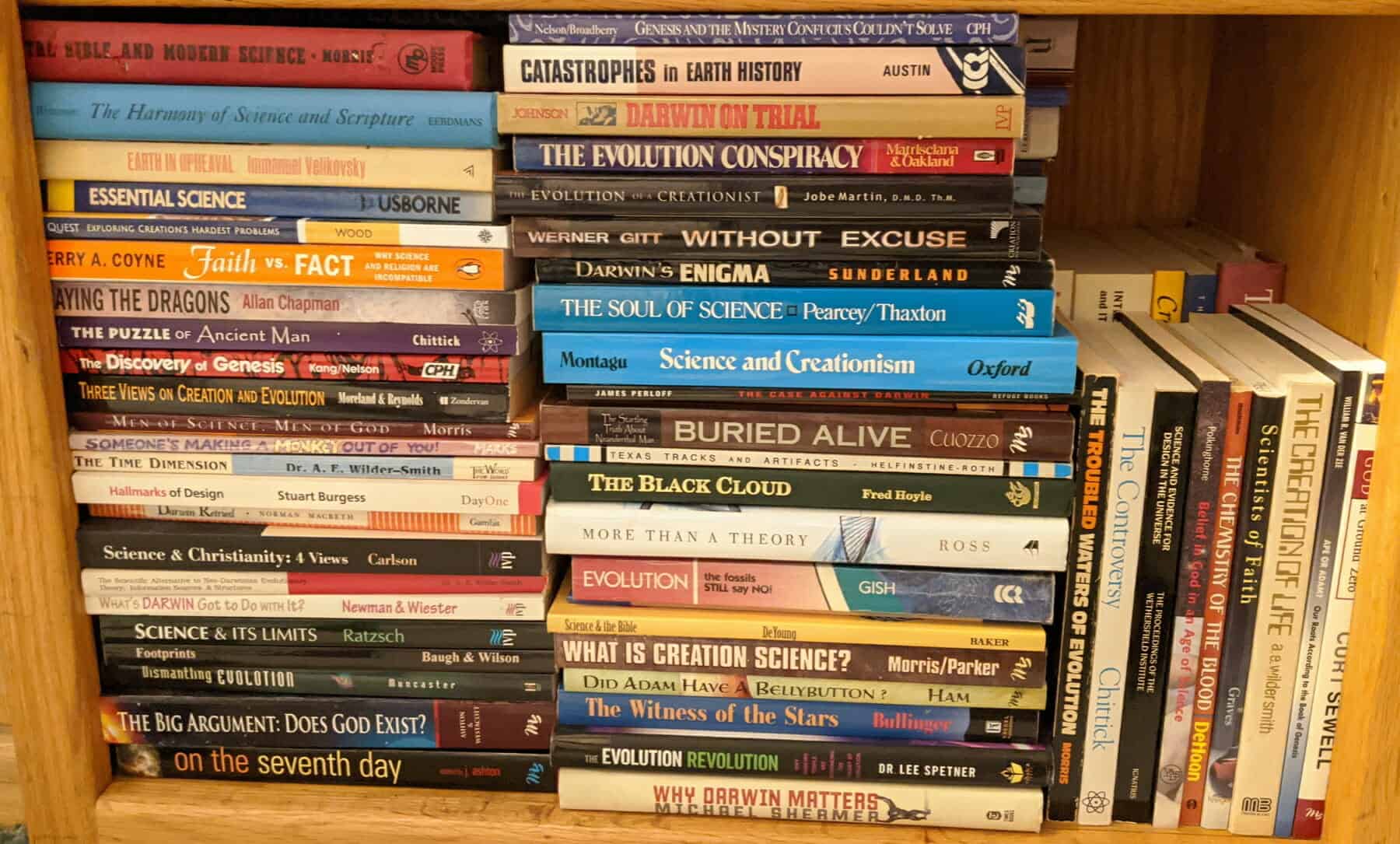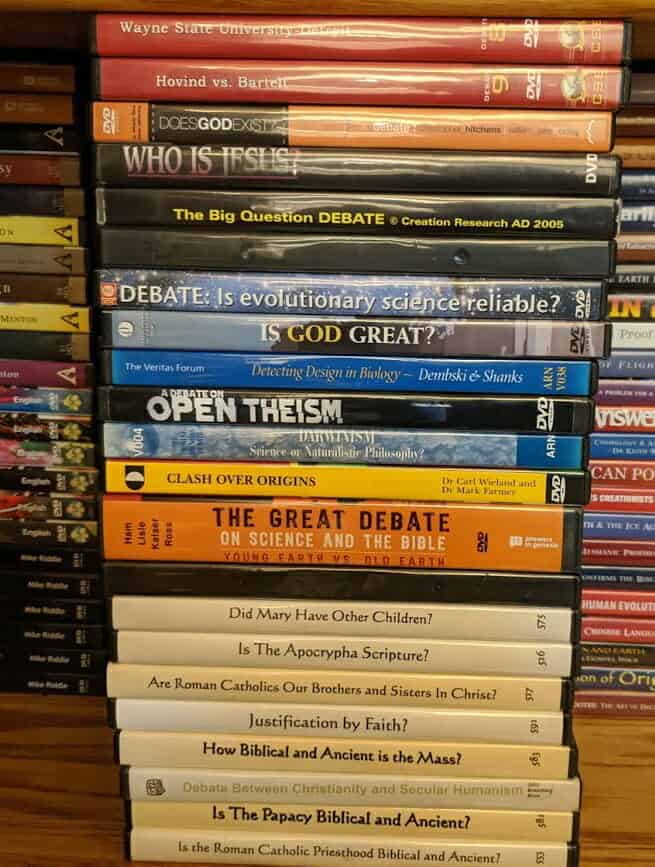(Hat-tip to Wintery Knight’s FACEBOOK) In a lively yet in-depth discussion, Piers Morgan drills down to the core of human existence with Stephen C. Meyer, the prominent ‘intelligent design’ advocate. In this Piers Morgan Uncensored special, Meyers firmly rejects the idea that a scientific worldview leads to atheism, arguing instead that ‘the universe requires a creator or cause’. When Richard Dawkin’s name is mentioned, Meyer claims that he actually really loves the atheist firebrand and admires his intensity. Lastly, Morgan and Meyers agree that the question of God’s existence is tied to more than just cold hard facts, but also human nature itself.
Intelligent Design
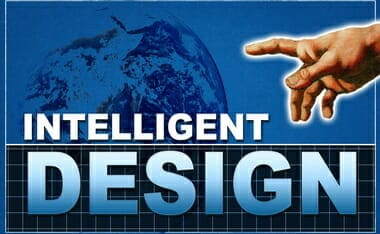
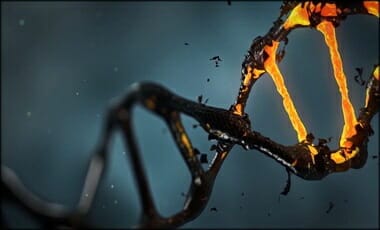
Evolutionists w/Egg On Their Faces – Failed Predictions
- the theory has been attacked on the grounds that many aspects of nature fail to show any evidence of intelligent design, such as “junk” DNA — R. T. Pennock (2002)
First, this is with a hat-tip to WINTERY KNIGHT! BTW, I posted on this many years back (jump below to my imports). Here is the video WK posted and then I will add more from him and my old posts.
VIDEO DESCRIPTION
Is the idea of junk DNA this one of the biggest mistakes in science in our lifetime? Only about 1% of our DNA codes for proteins, so what is the other 99% doing? Many evolutionary scientists over the years insisted that the non-protein coding DNA is largely junk, but intelligent design theorists predicted function will be prevalent throughout our genome. Guess which prediction turned out to be right?
Learn how scientists have discovered that the vast majority of our genome has function in this installment of the “Codes of Life” mini-series produced as part of the “Long Story Short” show on YouTube.
Find out more about scientific challenges to evolution. Download a free copy of the mini-book “Top 10 Scientific Problems With Evolution” here: TOP TEN PROBLEMS w/EVOLUTION. This free digital mini-book reviews the scientific literature and shows there are powerful scientific challenges to core tenets of Darwinian theory.
The key ideas here are this, Evolutionists predicted one thing. Intelligent Design proponents, another (EVOLUTION NEWS):
- …evolutionists predicted that, in line with their premise of a randomly generated genome, DNA would turn out to be full of Darwinian debris, playing no functional role but merely parasitic (atheist Richard Dawkins’s term) on the small portion of functional DNA.
- Proponents of intelligent design said the opposite. William Dembski (1998) and Richard Sternberg (2002) predicted widespread function for the so-called “junk.” After all, as a product of care and intention, the genome ought to be comparable in a way with products of human genius, with every detail there for a reason.
For instance, here is an article that John Woodmorappe wrote in 2002:
More and more noncoding DNA, long considered ‘junk DNA’, has eventually been found to be functional. Hardly more than a few months pass by and there is not another scientific paper demonstrating function for some form of junk DNA. As summarized in this article, there is also growing evidence that at least some pseudogenes are functional. It should be stressed that pseudogenes, unlike other so-called junk DNA, have long been burdened not only with the ingrained belief that they lack function, but also the additional onus of having supposedly lost a function. In addition, consider the following preconception relative to protein-coding genes in general:
‘Considerably less analysis of this type has been performed on coding regions, possibly because the bias present from the protein-encoding function represented as nucleotide triplets (codons) promotes the general assumption that secondary functionality is present infrequently in protein coding sequences.’
[….]
Against the backdrop of the customary negative opinion of pseudogenes, there have always been a few individuals who anticipated their functional potential. McCarrey (1986) et al. were probably the first to suggest that pseudogenes can be functional in terms of the regulation of the expression of its paralogous genes. They noted that the sense RNA transcribed by a gene could be effectively removed by hybridizing (forming a duplex) with the antisense RNA produced by the paralagous pseudogene. In addition, an otherwise nonfunctional peptide unit translated by the pseudogene could inhibit the peptide translated by the gene. They likened these processes to a buffered acid-base titration. As described below, their ideas proved prophetic.
Inouye apparently independently realized the same possibility for pseudogenes (1988)….
Of course, me being no scientist could also read the writing on the wall, similar to vestigial organs. Here are those old posts of mine:
Both posts are from Friday, June 15, 2007
Evolution Predicts “Junk”… Intelligent Design Predicts “Treasure”
A long trail of refuse is what has been left behind by the theory of evolution. From the many deaths because evolutionary theory taught that tonsils were vestigial, to stalled insight into the appendix. Now we have years lost in the study of what was known as “Junk DNA.” Many years ago I debated that this will be found not to be junk, but will be shown to be useful, and after the first Scientific American article about “Junk DNA” not being Junk DNA, I was using it as an example to bolster the Intelligent Design argument:
For instance you can find a response here that I wrote in March of 2005:
This is originally from VOLCONVO, a debate forum I graced many years ago, now defunct, under:
philosophy-religion/4153-global-myths-evolution-spin-off-3
It is nice to see more and more INFORMATION (pun intended) come out on this, and the prediction made by Intelligent Design leaders in 1994! (Taken from EVOLUTION NEWS article):
As far back as 1994, pro-ID scientist and Discovery Institute fellow Forrest Mims had warned in a letter to Science against assuming that ‘junk’ DNA was ‘useless.'” Science wouldn’t print Mims’ letter, but soon thereafter, in 1998, leading ID theorist William Dembski repeated this sentiment in First Things:
[Intelligent] design is not a science stopper. Indeed, design can foster inquiry where traditional evolutionary approaches obstruct it. Consider the term “junk DNA.” Implicit in this term is the view that because the genome of an organism has been cobbled together through a long, undirected evolutionary process, the genome is a patchwork of which only limited portions are essential to the organism. Thus on an evolutionary view we expect a lot of useless DNA. If, on the other hand, organisms are designed, we expect DNA, as much as possible, to exhibit function. And indeed, the most recent findings suggest that designating DNA as “junk” merely cloaks our current lack of knowledge about function. For instance, in a recent issue of the Journal of Theoretical Biology, John Bodnar describes how “non-coding DNA in eukaryotic genomes encodes a language which programs organismal growth and development.” Design encourages scientists to look for function where evolution discourages it.
(William Dembski, “Intelligent Science and Design,” First Things, Vol. 86:21-27 (October 1998)
If these scientists were coming from the perspective that everything was “designed” to begin with, they wouldn’t merely write off unknowns as “junk.”
10:13 PM
Killing in the Name of Darwin
The Dangers of Darwinism
People use to have their tonsils pulled whenever they were slightly inflamed. In the 1930’s over half of all children had their tonsils and adenoids removed. In 1969, 19.5 out of every 1,000 children under the age of nine had undergone a tonsillectomy. By 1971 the frequency had dropped to only 14.8 per 1,000, with the percentage continuing to decrease in subsequent years. Most medical authorities now actively discourage tonsillectomies. Many agree with Wooley, chairman of the department of pediatrics at Wayne State University, who was quoted in one study as saying: “If there are one million tonsillectomies done in the United States, there are 999,000 that don’t need doing.”
In the Medical World News (N. J. Vianna, Peter Greenwald, and U. N. Davies, September 10, 1973, p.10), a story stated that although removal of tonsils at a young age obviously eliminates tonsillitis (the inflammation of the tonsils) it may significantly increase the incidence of strep-throat and even Hodgkin’s disease. In fact, according to the New York Department of Cancer Control: “…people who have had tonsillectomies are nearly three times as likely to develop Hodgkin’s Disease, a form of cancer that attacks the lymphoid tissue” (Lawrence Galton, “All Those Tonsil Operations: Useless? Dangerous?”Parade, May 2 (1976), pp. 26ff).
Ken Miller, 13 years ago, said,
- “the designer made serious errors, wasting millions of bases of DNA on a blueprint full of junk and scribbles. Evolution, in contrast, can easily explain them as nothing more than failed experiments in a random process.” (ARN and UNCOMMON DECENT)
The SCIENCE DAILY article that the above ARN article links to has this to say:
“This impressive effort has uncovered many exciting surprises and blazed the way for future efforts to explore the functional landscape of the entire human genome,” said NHGRI Director Francis S. Collins, M.D., Ph.D. “Because of the hard work and keen insights of the ENCODE consortium, the scientific community will need to rethink some long-held views about what genes are and what they do, as well as how the genome’s functional elements have evolved. This could have significant implications for efforts to identify the DNA sequences involved in many human diseases.”….
….The ENCODE consortium’s major findings include the discovery that the majority of DNA in the human genome is transcribed into functional molecules, called RNA, and that these transcripts extensively overlap one another. This broad pattern of transcription challenges the long-standing view that the human genome consists of a relatively small set of discrete genes, along with a vast amount of so-called junk DNA that is not biologically active.
Thanks to the design theorists who predicted this outcome for the Intelligent Design theory, and for showing how this revelation refutes the prediction (yet again) that we should see if evolution is true. That is, useless genes and DNA.
10:34 PM
SEE OTHER POSTS HERE ON MY .COM:
- Gregory Koukl Interviews Stephen Meyer on a Myriad of Topics (2012)
- Pseudogenes Predicted To Fail by Creationists (Updated w/Appendix) (2016)
- Meanderings on Atheism, Darwinism, and Science (2016)
- MYTH: Human/Chimpanzee Similarities (2018)
- Junk DNA: Evolutionary Arguments Helping Prove God (2018)
- Junk DNA and Genetic Comparisons of Chimps and Humans (2023)

A “High-Brow” Defection from Darwinian Naturalism | Thomas Nagel
Originally Posted November of 2012
Here Dr. William Lane Craig demonstrates that atheism cannot give an account for reason, logic, and truth.
EVOLUTION NEWS AND VIEWS has this bitchin post:
About a decade ago I would muse on what it might take for intelligent design to win the day. Clearly, its intellectual and scientific project needed to move forward, and, happily, that has been happening. But I was also thinking in terms of a watershed event, something that could have the effect of a Berlin Wall coming down, so that nothing thereafter was the same. It struck me that an event like this could involve some notable atheists coming to reverse themselves on the evidence for design in the cosmos.
Shortly after these musings, Antony Flew, who had been the most notable intellectual atheist in the English-speaking world until Richard Dawkins supplanted him, announced that he had come to believe in God (a deistic deity and not the full-blooded deity of ethical monotheism) on account of intelligent design arguments. I wondered whether this could be the start of that Berlin Wall coming down, but was quickly disabused as the New York Times and other media outlets quickly dismissed Flew’s conversion as a sign of his dotage (he was in his eighties when he deconverted from atheism). Flew, though sound in mind despite what his critics were saying (I spoke with him on the phone in 2006), was quickly marginalized and his deconversion didn’t have nearly the impact that it might have.
Still, I may have been on to something about defections of high profile intellectuals from Darwinian naturalism and the effect that this might have in creating conceptual space for intelligent design and ultimately winning the day for it. In 2011 we saw University of Chicago molecular biologist James Shapiro deconstruct Darwinian evolution with an incisiveness and vigor that even the ID community has found hard to match (for my review of his Evolution: A View from the 21st Century, go here; for my exchange with Shapiro on this forum, go here).
A Most Disconcerting Deconversion
Thomas Nagel, with his just published Mind & Cosmos, has now become another such defector from Darwinian naturalism. Appearing from Oxford University Press and subtitled Why the Materialist Neo-Darwinian Conception of Nature is Almost Certainly False, this slender volume (it’s only 130 pages) represents the most disconcerting defection (disconcerting to Darwinists) from Darwinian naturalism to date. We’re still not talking the Berlin Wall coming down, but it’s not hard to see it as a realistic possibility, off in the distance, after reading this book.
Because intelligent design is still a minority position that is widely marginalized by the media and mainstream science, it’s easy for defenders of intelligent design to wax apocalyptic. Indeed, it’s a very natural impulse to want to throw off the shackles of an oppressive and powerful majority, especially when one views their authority as unwarranted and unjust. So I have to keep my own impulses in check when I make comments about the Berlin Wall coming down (by the way, I had an uncle, aunt, and cousins who lived in “West Berlin” at the time as well as relatives in Poland, so my interest in the Berlin Wall is not merely hypothetical). But Thomas Nagel is a very major intellectual on the American scene and his no-holds-barred deconstruction of Darwinian naturalism is just the sort of critique, coupled with others to be sure, that will, if anything, unravel Darwin’s legacy.
Nagel is a philosopher at New York University. Now in his 70s, he has been a towering figure in the field, and his essays were mandatory reading, certainly when I was a graduate student in philosophy in the early 1990s. His wildly popular essay “What Is It Like to Be a Bat?” takes on reductionist accounts of mind, and his books Mortal Questions (Cambridge, 1979) and The View from Nowhere (Oxford, 1986) seemed to be in many of my fellow graduate students’ backpacks.
Reading Nagel’s latest, I had the sense of watching Peter Finch in the film Network (1976), where he rants “I’m mad as hell and I’m not going to take this anymore” (in that famous monologue, Finch also says “I’m a human being, my life has value” — a remarkable point to make three years after Roe v. Wade; to see the monologue, go here). Now Nagel in Mind & Cosmos, unlike Finch in Network, is measured and calm, but he is no less adamant that the bullying by Darwinists needs to stop. Perhaps with Richard Dawkins in mind, who has remarked that dissenters from Darwin are either ignorant, stupid, wicked, insane, or brainwashed, Nagel writes,
I realize that such doubts [about Darwinian naturalism] will strike many people as outrageous, but that is because almost everyone in our secular culture has been browbeaten into regarding the reductive research program as sacrosanct, on the ground that anything else would not be science.
Nagel has nailed it here. The threat of being branded unscientific in the name of a patently ill-supported Darwinian evolutionary story is the thing that most keeps Darwinism alive (certainly not the evidence for it). We saw a similar phenomenon in the old communist Eastern bloc. Lots of people doubted Marxism-Leninism. But to express such doubt would get one branded as a reactionary. And so people kept silent. I recall David Berlinski, a well-known Darwin skeptic, telling me about a reading group at MIT among faculty there who studied his work but did so sub rosalest they have to face the wrath of Darwinists.
In Mind & Cosmos, Nagel serves notice on Darwinists that their coercive tactics at ensuring conformity have not worked with him and, if his example inspires others, won’t work with them either. What a wonderful subtitle to his book: Why the Materialist Neo-Darwinian Conception of Nature is Almost Certainly False. It’s a dare. Go ahead, make my day, do your worst to bring the wrath of Darwin’s devoted disciples on me. Nagel regards the emperor as without clothes and says so:
For a long time I have found the materialist account of how we and our fellow organisms came to exist hard to believe, including the standard version of how the evolutionary process works. The more details we learn about the chemical basis of life and the intricacy of the genetic code, the more unbelievable the standard historical account becomes. This is just the opinion of a layman who reads widely in the literature that explains contemporary science to the nonspecialist. Perhaps that literature presents the situation with a simplicity and confidence that does not reflect the most sophisticated scientific thought in these areas. But it seems to me that, as it is usually presented, the current orthodoxy about the cosmic order is the product of governing assumptions that are unsupported, and that it flies in the face of common sense.
William Lane Craig shows how the naturalist cannot trust their own thinking. He mentioned Alvin Plantinga who argues that if evolution is true that spells trouble for the atheist. Indeed, can the atheist (who calls himself a “free thinker”) be free if his brain is no more than matter and motion dictated by the laws of nature?
And this update from The Weekly Standard [DEFUNCT] now at WASHINIGTON EXAMINER:
Last fall, a few days before Halloween and about a month after the publication of Mind and Cosmos, the controversial new book by the philosopher Thomas Nagel, several of the world’s leading philosophers gathered with a group of cutting-edge scientists in the conference room of a charming inn in the Berkshires. They faced one another around a big table set with pitchers of iced water and trays of hard candies wrapped in cellophane and talked and talked, as public intellectuals do. PowerPoint was often brought into play.
The title of the “interdisciplinary workshop” was “Moving Naturalism Forward.” For those of us who like to kill time sitting around pondering the nature of reality—personhood, God, moral judgment, free will, what have you—this was the Concert for Bangladesh. The biologist Richard Dawkins was there, author of The Blind Watchmaker, The Selfish Gene, and other bestselling books of popular science, and so was Daniel Dennett, a philosopher at Tufts and author of Consciousness Explained and Darwin’s Dangerous Idea: Evolution and the Meanings of Life. So were the authors of Why Evolution is True, The Really Hard Problem: Meaning in a Material World, Everything Must Go: Metaphysics Naturalized, and The Atheist’s Guide to Reality: Enjoying Life without Illusions—all of them books that to one degree or another bring to a larger audience the world as scientists have discovered it to be.
[….]
Daniel Dennett took a different view. While it is true that materialism tells us a human being is nothing more than a “moist robot”—a phrase Dennett took from a Dilbert comic—we run a risk when we let this cat, or robot, out of the bag. If we repeatedly tell folks that their sense of free will or belief in objective morality is essentially an illusion, such knowledge has the potential to undermine civilization itself, Dennett believes. Civil order requires the general acceptance of personal responsibility, which is closely linked to the notion of free will. Better, said Dennett, if the public were told that “for general purposes” the self and free will and objective morality do indeed exist—that colors and sounds exist, too—“just not in the way they think.” They “exist in a special way,” which is to say, ultimately, not at all.
[….]
…How did we lose Tom….
Thomas Nagel may be the most famous philosopher in the United States—a bit like being the best power forward in the Lullaby League, but still. His paper “What Is It Like to Be a Bat?” was recognized as a classic when it was published in 1974. Today it is a staple of undergraduate philosophy classes. His books range with a light touch over ethics and politics and the philosophy of mind. His papers are admired not only for their philosophical provocations but also for their rare (among modern philosophers) simplicity and stylistic clarity, bordering sometimes on literary grace.
Nagel occupies an endowed chair at NYU as a University Professor, a rare and exalted position that frees him to teach whatever course he wants. Before coming to NYU he taught at Princeton for 15 years. He dabbles in the higher journalism, contributing articles frequently to the New York Review of Books and now and then to the New Republic. A confirmed atheist, he lacks what he calls the sensus divinitatis that leads some people to embrace the numinous. But he does possess a finely tuned sensus socialistis; his most notable excursion into politics was a book-length plea for the confiscation of wealth and its radical redistribution—a view that places him safely in the narrow strip of respectable political opinion among successful American academics.
For all this and more, Thomas Nagel is a prominent and heretofore respected member of the country’s intellectual elite. And such men are not supposed to write books with subtitles like the one he tacked onto Mind and Cosmos: Why the Materialist Neo-Darwinian Conception of Nature Is Almost Certainly False.
Imagine if your local archbishop climbed into the pulpit and started reading from the Collected Works of Friedrich Nietzsche. “What has gotten into Thomas Nagel?” demanded the evolutionary psychologist Steven Pinker, on Twitter. (Yes, even Steven Pinker tweets.) Pinker inserted a link to a negative review of Nagel’s book, which he said “exposed the shoddy reasoning of a once-great thinker.” At the point where science, philosophy, and public discussion intersect—a dangerous intersection these days—it is simply taken for granted that by attacking naturalism Thomas Nagel has rendered himself an embarrassment to his colleagues and a traitor to his class.
The Guardian awarded Mind and Cosmos its prize for the Most Despised Science Book of 2012. The reviews were numerous and overwhelmingly negative; one of the kindest, in the British magazine Prospect, carried the defensive headline “Thomas Nagel is not crazy.” (Really, he’s not!) Most other reviewers weren’t so sure about that. Almost before the ink was dry on Nagel’s book the UC Berkeley economist and prominent blogger Brad DeLong could be found gathering the straw and wood for the ritual burning. DeLong is a great believer in neo-Darwinism. He has coined the popular term “jumped-up monkeys” to describe our species. (Monkeys because we’re descended from primates; jumped-up because evolution has customized us with the ability to reason and the big brains that go with it.)
DeLong was particularly offended by Nagel’s conviction that reason allows us to “grasp objective reality.” A good materialist doesn’t believe in objective reality, certainly not in the traditional sense. “Thomas Nagel is not smarter than we are,” he wrote, responding to a reviewer who praised Nagel’s intelligence. “In fact, he seems to me to be distinctly dumber than anybody who is running even an eight-bit virtual David Hume on his wetware.” (What he means is, anybody who’s read the work of David Hume, the father of modern materialism.) DeLong’s readers gathered to jeer as the faggots were placed around the stake.
“Thomas Nagel is of absolutely no importance on this subject,” wrote one. “He’s a self-contradictory idiot,” opined another. Some made simple appeals to authority and left it at that: “Haven’t these guys ever heard of Richard Dawkins and Daniel Dennett?” The hearts of still others were broken at seeing a man of Nagel’s eminence sink so low. “It is sad that Nagel, whom my friends and I thought back in the 1960’s could leap over tall buildings with a single bound, has tripped over the Bible and fallen on his face. Very sad.”
Nagel doesn’t mention the Bible in his new book—or in any of his books, from what I can tell—but among materialists the mere association of a thinking person with the Bible is an insult meant to wound, as Bertie Wooster would say. Directed at Nagel, a self-declared atheist, it is more revealing of the accuser than the accused. The hysterical insults were accompanied by an insistence that the book was so bad it shouldn’t upset anyone.
“Evolutionists,” one reviewer huffily wrote, “will feel they’ve been ravaged by a sheep.” Many reviewers attacked the book on cultural as well as philosophical or scientific grounds, wondering aloud how a distinguished house like Oxford University Press could allow such a book to be published. The Philosophers’ Magazine described it with the curious word “irresponsible.” How so? In Notre Dame Philosophical Reviews, the British philosopher John Dupré explained. Mind and Cosmos, he wrote, “will certainly lend comfort (and sell a lot of copies) to the religious enemies of Darwinism.” Simon Blackburn of Cambridge University made the same point: “I regret the appearance of this book. It will only bring comfort to creationists and fans of ‘intelligent design.’ ”
But what about fans of apostasy? You don’t have to be a biblical fundamentalist or a young-earth creationist or an intelligent design enthusiast—I’m none of the above, for what it’s worth—to find Mind and Cosmos exhilarating. “For a long time I have found the materialist account of how we and our fellow organisms came to exist hard to believe,” Nagel writes. “It is prima facie highly implausible that life as we know it is the result of a sequence of physical accidents together with the mechanism of natural selection.” The prima facie impression, reinforced by common sense, should carry more weight than the clerisy gives it. “I would like to defend the untutored reaction of incredulity to the reductionist neo-Darwinian account of the origin and evolution of life.”
[….]
Nagel follows the materialist chain of reasoning all the way into the cul de sac where it inevitably winds up. Nagel’s touchier critics have accused him of launching an assault on science, when really it is an assault on the nonscientific uses to which materialism has been put. Though he does praise intelligent design advocates for having the nerve to annoy the secular establishment, he’s no creationist himself. He has no doubt that “we are products of the long history of the universe since the big bang, descended from bacteria through millions of years of natural selection.” And he assumes that the self and the body go together. “So far as we can tell,” he writes, “our mental lives, including our subjective experiences, and those of other creatures are strongly connected with and probably strictly dependent on physical events in our brains and on the physical interaction of our bodies with the rest of the physical world.” To believe otherwise is to believe, as the materialists derisively say, in “spooky stuff.” (Along with jumped-up monkeys and moist robots and countless other much-too-cute phrases, the use of spooky stuff proves that our popular science writers have spent a lot of time watching Scooby-Doo.) Nagel doesn’t believe in spooky stuff.
Materialism, then, is fine as far as it goes. It just doesn’t go as far as materialists want it to. It is a premise of science, not a finding. Scientists do their work by assuming that every phenomenon can be reduced to a material, mechanistic cause and by excluding any possibility of nonmaterial explanations. And the materialist assumption works really, really well—in detecting and quantifying things that have a material or mechanistic explanation. Materialism has allowed us to predict and control what happens in nature with astonishing success. The jaw-dropping edifice of modern science, from space probes to nanosurgery, is the result.
But the success has gone to the materialists’ heads. From a fruitful method, materialism becomes an axiom: If science can’t quantify something, it doesn’t exist, and so the subjective, unquantifiable, immaterial “manifest image” of our mental life is proved to be an illusion.
Here materialism bumps up against itself. Nagel insists that we know some things to exist even if materialism omits or ignores or is oblivious to them. Reductive materialism doesn’t account for the “brute facts” of existence—it doesn’t explain, for example, why the world exists at all, or how life arose from nonlife. Closer to home, it doesn’t plausibly explain the fundamental beliefs we rely on as we go about our everyday business: the truth of our subjective experience, our ability to reason, our capacity to recognize that some acts are virtuous and others aren’t. These failures, Nagel says, aren’t just temporary gaps in our knowledge, waiting to be filled in by new discoveries in science. On its own terms, materialism cannot account for brute facts. Brute facts are irreducible, and materialism, which operates by breaking things down to their physical components, stands useless before them. “There is little or no possibility,” he writes, “that these facts depend on nothing but the laws of physics.” …
Aren’t atheists supposed to be “free thinkers”? They often call themselves that. But if atheism is true, there is no “free” and there is no “thinking “ going on. We are all just molecular machines. Dr. Tim Stratton of Freethinking Ministries shares the stage with Frank to explain why.
And a recent addition by EVOLUTION NEWS AND VIEWS:
John West’s updated and expanded book, out this week, Darwin Day in America: How Our Politics and Culture Have Been Dehumanized in the Name of Science.
In an all new added chapter, West recounts among other recent developments the sensation that followed the publication of Thomas Nagel’s book Mind and Cosmos: Why the Materialist Neo-Darwinian Conception of Nature Is Almost Certainly False. The renowned atheist philosopher expressed admiration for advocates of intelligent design including Meyer, Behe, and Berlinski.
What was the nub of his critique of neo-Darwinism?
Nagel ultimately offered a simple but profound objection to Darwinism: “Evolutionary naturalism provides an account of our capacities that undermines their reliability, and in doing so undermines itself.” In other words, if our mind and morals are simply the accidental products of a blind material process like natural selection acting on random genetic mistakes, what confidence can we have in them as routes to truth?
The basic philosophical critique of Darwinian reductionism offered by Nagel had been made before, perhaps most notably by Sir Arthur Balfour, C.S. Lewis, and Alvin Plantinga. But around the same time as the publication of Nagel’s book came new scientific discoveries that undermined Darwinian materialism as well. In the fall of 2012, the Encyclopedia of DNA Elements (ENCODE) project released results showing that much of so-called junk DNA actually performs biological functions. The ENCODE results overturned long-repeated claims by leading Darwinian biologists that most of the human genome is genetic garbage produced by a blind evolutionary process. At the same time, the results confirmed predictions made during the previous decade by scholars who think nature displays evidence of intelligent design.
New scientific challenges to orthodox Darwinian theory have continued to proliferate. In 2013 Stephen Meyer published Darwin’s Doubt: The Explosive Origin of Animal Life and the Case for Intelligent Design, which threw down the gauntlet on the question of the origin of biological information required to build animal body plans in the history of life. The intriguing thing about Meyer’s book was not the criticism it unleashed from the usual suspects but the praise it attracted from impartial scientists. Harvard geneticist George Church lauded it as “an opportunity for bridge-building rather than dismissive polarization — bridges across cultural divides in great need of professional, respectful dialogue.” Paleontologist Mark McMenamin, coauthor of a major book from Columbia University Press on animal origins, called it “a game changer for the study of evolution” that “points us in the right direction as we seek a new theory for the origin of animals.”
Even critics of Darwin’s Doubt found themselves at a loss to come up with a convincing answer to Meyer’s query about biological information. University of California at Berkeley biologist Charles Marshall, one of the world’s leading paleontologists, attempted to answer Meyer in the pages of the journal Science and in an extended debate on British radio. But as Meyer and others pointed out, Marshall tried to explain the needed information by simply presupposing the prior existence of even more unaccounted-for genetic information. “That is not solving the problem,” said Meyer. “That’s just begging the question.”
C. S. Lewis perceptively observed in his final book that “nature gives most of her evidence in answer to the questions we ask her.” Lewis’s point was that old paradigms often persist because they blind us from asking certain questions. They begin to disintegrate once we start asking the right questions. Scientific materialism continues to surge, but perhaps the right questions are finally beginning to be asked.
It remains to be seen whether as a society we will be content to let those questions be begged or whether we will embrace the injunction of Socrates to “follow the argument . . . wherever it may lead.” The answer to that question may determine our culture’s future.
J. Warner Wallace responds to “we don’t have free will”?
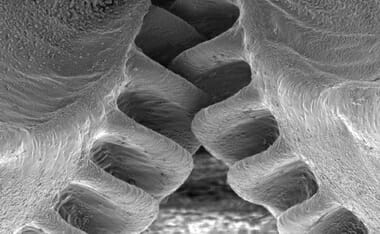
NANOTECHNOLOGY | Gears, Motors, and “Cogs”
(Originally posted September of 2013)
NANOTECHNOLOGY
Gears, Motors, and “Cogs”
How does [chance] selection arrive at such coordination? What good is one gear without the corresponding gear? The challenge of IC [irreducible complexity] for Darwinism remains. ~ Uncommon Descent
Mechanical gears – like those found in clocks – have been around since the Greeks are thought to have invented them around 300 B.C. But scientists have now discovered a small hopping insect equipped with a set of living gears! University of Cambridge biologists discovered that Issus coleoptratus have an intricate gearing system that locks their back legs together. This allows both legs to spring at the exact same instant, propelling the tiny creatures straight forward. If one of the bug’s legs jumped a fraction of a second earlier than the other, this would push the insect off course to the left or right. The gears are located at the top of the insects’ hind legs and include 10 to 12 tapered teeth. The teeth of the gear lock together neatly, and they even have curves at the base, a design incorporated into man-made mechanical gears to reduce wear over time. Researcher Gregory Sutton said, “We usually think of gears as something that we see in human-designed machinery…. These gears are not designed; they are evolved – representing high speed and precision machinery evolved for synchronisation in the animal world.” What we’d like to ask him is how did this insect survive for thousands of years while it couldn’t jump straight? No, there is a much simpler explanation that scientists might see if they weren’t so biased against a Creator. The gears were designed by God, who gave all of His creatures – including you and me – all of the intricate parts we need!
Mind you, we have tiny motors (complete) found in nature that likewise fit Darwin’s own challenge of irreducible complexity — disproving neo-Darwinian positions… however, these gears provide yet another of many irreducible complexities that philosophical naturalism is hard-pressed to answer.
Atheist evangelist ~ Richard Dawkins ~ famous quip almost seems painfully funny:
- “Biology is the study of complicated things that give the appearance of having been designed for a purpose.” (See more here)
Here is another evidence of “irreducibilities” found in nanotechnology, the Kinesin Motor:
Via, EVOLUTION NEWS AND VIEWS: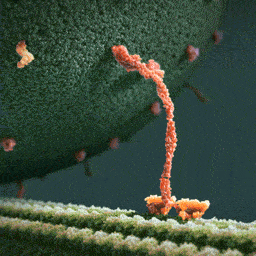
One of the most amazing examples of cellular nanotechnology is a molecular motor protein known as kinesin. Kinesin is responsible for transporting molecular cargo — including chromosomes (e.g. during cell division), neurotransmitters and other important material — along microtubule tracks from one region of the cell to another. It is driven by ATP hydrolysis, thereby converting chemical energy into mechanical energy which it can use for movement. A kinesin molecule typically possesses two tails on one end, which attach to the cargo, in addition to two globular heads (often called “motor domains”) on the other end. Some readers may recognize this elegant protein from the now-famous Harvard animation, Inner Life of the Cell (time 1:59).
The sheer number of processes needed to be undertaken by such a motor protein makes the appearance of intelligent design seem almost beyond rational denial. Of course, many people resist this conclusion despite the evidence. As one Science Daily article in October 2010 put it,
“Our results show that a molecular motor must take on a large number of functions over and above simple transport, if it wants to operate successfully in a cell,” says Professor Matthias Rief from the Physics Department of the TU Muenchen. It must be possible to switch the motor on and off, and it must be able to accept a load needed at a specific location and hand it over at the destination. “It is impressive how nature manages to combine all of these functions in one molecule,” Rief says. “In this respect it is still far superior to all the efforts of modern nanotechnology and serves as a great example to us all.” [emphasis added]….
The General Theory of Evolution contends that every lifeform on Earth came about by non-purposeful, unintelligent accidents. Yet many evolutionists repeatedly refer to seeing amazing design in nature. But can design exist without a designer? Join Eric Lyons as he looks at the remarkable design we see, even down to the smallest creatures on Earth, all of which point to a Grand Designer.
Information drives the development of life. But what is the source of that information? Could it have been produced by an unguided Darwinian evolutionary process? Or did it require intelligent design? The Information Enigma is a fascinating 21-minute documentary that probes the mystery of biological information, the challenge it poses to orthodox Darwinian theory, and the reason it points to intelligent design. The video features Dr. Stephen Meyer, and molecular biologist Douglas Axe, founder of the Biologic Institute. For more about intelligent design theory be sure to visit “Intelligent Design: The Definitive Source on Intelligent Design“
If you watch the short videos below, keep in mind that all this complexity at the cellular/protein level needs to be up and running optimally for life to have happened… at all.
And what one should keep in mind is the time-factor in all this “evolution” involved in event the simplest working protein… even long time (billions of years) is not enough time to get “the show on the road” ~ see Not Enough Evolutionary Time.
The idea that Behe’s flagellum motor has been answered is wishful thinking at best, and corrupt science at it’s worst (scientism: which is an insertion of a metaphysical principle stating things like “the only quantifiable reality known is the one made up of atoms, and, science [thus defined] is the best means to understanding said reality”). Really, then, it is an “evolution-of-the-gaps” type thinking.
✿ Ken Miller’s challenge can be read here;
✿ Responses to it and derivatives to it can be found here.
But as one can see… these giants of I.D. did truly wipe the floor with their critics [full exchange].
By-the-way, all this just got WAY MORE complex. For instance, here is the fast-swimming magnetotactic bacterium MO-1… it has 7-flagellum motors… with counter gears:
Here is a basic animation:
One should see Malcolm Bowden’s presentation on YouTube of the bacterium MO-1 as well.
And NOW even more complex is the fact that quantum mechanics may play a role (unrelated to the DNA or RNA) that folds these proteins into the shape for pieces to the whole of the working part.
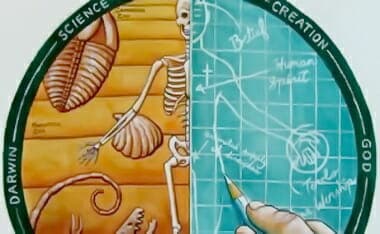
Scientific and Anecdotal Evidence for the Beginning of the Universe
(Originally Posted December of 2015)
Please see “Theistic Implications of Big-Bang Cosmology“ for more on this topic.
- The editor of the prestigious weekly science periodical, Nature, John Maddox, wrote an editorial entitled, “Down with the Big Bang,” where he hoped for the downfall of the Big Bang model, because in it, he found it to be “philosophically unacceptable,” quote: “Apart from being philosophically unacceptable, the Big-Bang is an over-simple view of how the Universe began, and it is unlikely to survive the decade ahead.” ~ Maddox, J. 1989. Down with the Big Bang. Nature 340: 425.
- Physicist Hubert Reeves remarked that the Big Bang “involves a certain metaphysical aspect which may be either appealing or revolting” ~ Reeves, H., Andouze, J., Fowler, W. A., and Schramm, D. N. 1973. On the Origin of the Light Elements. Astrophysical Journal 179: 912.
- Cosmologist Christopher Isham: “Perhaps the best argument in favor of the thesis that the Big Bang supports theism is the obvious unease with which it is greeted by some atheist physicists. At times this has led to scientific ideas, such as continuous creation [steady state] or an oscillating universe, being advanced with a tenacity which so exceeds their intrinsic worth that one can only suspect the operation of psychological forces lying very much deeper than the usual academic desire of a theorist to support his/her theory.” ~ Isham, C. 1988. “Creation of the Universe as a Quantum Process,” in Physics, Philosophy, and Theology, A Common Quest for Understanding, eds. R. J. Russell, W. R. Stoeger, and G. V. Coyne, Vatican City State: Vatican Observatory, p. 378.
(SOURCE — see the previous slide as well)
- “The biggest problem with the Big Bang theory of the origin of the universe is philosophical–perhaps even theological–what was there before the bang? This problem alone was sufficient to give a great initial impetus to the Steady State theory; but with that theory now sadly in conflict with the observations, the best way round this initial difficulty is provided by a model in which the universe expands from a singularity, collapses back again, and repeats the cycle indefinitely” (John Gribbin, “Oscillating Universe Bounces Back,” Nature 259 [1976]: 15).
(SOURCE)
Lee Strobel does a great job in relaying the evidence that we live in a finite cosmos and not an infinite one in his discussion with Dr. William Lane Craig [I added J. Warner Wallace as well to this presentation]:
When Albert Einstein developed his general theory of relativity in 1915 and started applying it to the universe as a whole, he was shocked to discover it didn’t allow for a static universe. According to his equations, the universe should either be exploding or imploding. In order to make the universe static, he had to FUDGE his equations by putting in a factor that would hold the universe steady.
In the 1920’s, the Russian mathematician Alexander Friedman and the Belgium astronomer George Lemaitre were able to develop models based on Einstein’s theory. They predicted the universe was expanding. Of course, this meant that if you went backward in time, the universe would go back to a single origin before which it didn’t exist. Astronomer Fred Hoyle derisively called this the Big Bang — and the name stuck! [Later in his career, Fred Hoyle confirmed the expansion through work on the second most plentiful element in the universe, helium.]
Starting in the 1920’s, scientists began to find empirical evidence that supported these purely mathematical models.
LET US TAKE A QUICK BREAK from this excerpt to fill in some information from another excerpt, and then we will continue: As mathematicians explored the theoretical evidence, astronomers began to make observations confirming the expansion of the universe. Vesto Slipher, an American astronomer working at the Lowell Observatory. in Flagstaff, Arizona, spent nearly ten years perfecting his understanding of spectrograph readings. His observations revealed something remarkable. If a distant object was moving toward Earth, its observable spectrograph colors shifted toward the blue end of the spectrum. If a distant object was moving away from Earth, its colors shifted toward the red end of the spectrum. Slipher identified several nebulae and observed a redshift in their spectrographic colors. If these nebulae were moving away from our galaxy (and one another), as Slipher observed, they must have once been tightly clustered together. In 1914, he offered these findings at a meeting of the American Astronomical Society, proposing them as evidence the universe was expanding. A graduate student named Edwin Hubble seas in attendance and realized the implications of Slipher’s work. Hubble later began working at the Mount Wilson Observatory in Los Angeles. Using the Hooker telescope, he eventually proved Slipher’s nebulae were actually galaxies beyond the Milky Way composed of billions of stars. By 1929, Hubble published findings of his own, verifying Slipher’s observations and demonstrating the speed at which a star or galaxy moves away from us increases with its distance from Earth. This once again confirmed the expansion of the universe. …CONTINUING… For instance, in 1929, the American astronomer Edwin Hubble discovered that the light coming to us from distant galaxies appears redder than it should be, and this is a universal feature of galaxies in all parts of the sky. Hubble explained this red shift as being due to the fact that the galaxies are moving away from us. He concluded that the universe is literally flying apart at enormous velocities. Hubble’s astronomical observations were the first empirical confirmation of the predictions by Friedman and Lemaitre. Then in the 1940’s, George Gamow predicted that if the Big Bang really happened, then the background temperature of the universe should be just a few degrees above absolute zero. He said this would be a relic from a very early stage of the universe. Sure enough, in 1965, two scientists accidentally discovered the universe’s background radiation — and it was only about 3.7 degrees above absolute zero. There’s no explanation for this apart from the fact that it is a vestige of a very early and a very dense state of the universe, which was predicted by the Big Bang model. The third main piece of the evidence for the Big Bang is the origin of light elements. Heavy elements, like carbon and iron, are synthesized in the interior of stars and then exploded through supernova into space. But the very, very light elements, like deuterium and helium, cannot have been synthesized in the interior of the stars, because you would need an even more powerful furnace to create them. These elements must have been forged in the furnace of the Big Bang itself at temperatures that were billions of degrees. There’s no other explanation. So predictions about the Big Bang have been consistently verified by the scientific data. Moreover, they have been corroborated by the failure of every attempt to falsify them by alternative models. Unquestionably, the Big Bang model has impressive scientific credentials… Up to this time, it was taken for granted that the universe as a whole was a static, eternally existing object…. At the time an agnostic, American astronomer Robert Jastrow was forced to concede that although details may differ, “the essential element in the astronomical and Biblical accounts of Genesis is the same; the chain of events leading to man commenced suddenly and sharply, at a definite moment in time, in a flash of light and energy”…. Einstein admitted the idea of the expanding universe “irritates me” (presumably, said one prominent scientist, “because of its theological implications”)
This should be put in bullet points for easy memorization:
- Albert Einstein developed his general theory of relativity in 1915;
- Around the same time evidence of an expanding universe was being presented to the American Astronomical Society by Vesto Slipher;
- In the 1920s using Einstein’s theory, a Russian mathematician (Alexander Friedman) and the Belgium astronomer (George Lemaitre) predicted the universe was expanding;
- In 1929, Hubble discovered evidence confirming earlier work on the Red-Light shift showing that galaxies are moving away from us;
- In the 1940’s, George Gamow predicted a particular temperature to the universe if the Big Bang happened;
- In 1965, two scientists (Arno Penzias and Robert Woodrow Wilson) discovered the universe’s background radiation — and it was only about 3.7 degrees above absolute zero.
“In speaking of the fear of religion, I don’t mean to refer to the entirely reasonable hostility toward certain established religions and religious institutions, in virtue of their objectionable moral doctrines, social policies, and political influence. Nor am I referring to the association of many religious beliefs with superstition and the acceptance of evident empirical falsehoods. I am talking about something much deeper–namely, the fear of religion itself. I speak from experience, being strongly subject to this fear myself: I want atheism to be true and am made uneasy by the fact that some of the most intelligent and well-informed people I know are religious believers.
I want atheism to be true and am made uneasy by the fact that some of the most intelligent and well-informed people I know are religious believers. It isn’t just that I don’t believe in God and, naturally, hope that I’m right in my belief. It’s that I hope there is no God! I don’t want there to be a God; I don’t want the universe to be like that.”
In this extended conversation released as part of the Science Uprising series, best-selling author Stephen Meyer discusses the big bang, whether you can have an expanding universe without a beginning, and the most common ways scientists have tried to avoid a beginning to the universe. Along the way, Meyer addresses the ideas of Albert Einstein, Stephen Hawking, Edwin Hubble, Lawrence Krauss, Sean Carroll, and more.
Here I will post a portion of a response to a local author on the issue that part of the above was likewise used:
(You can click top enlarge)
Here are just two (of the many examples I can provide) of an atheist and an agnostic commenting on the above evidence:
➤ “The essential element in the astronomical and biblical accounts of Genesis is the same; the chain of events leading to man commenced suddenly and sharply, at a definite moment in time, in a flash of light and energy…. The Hubble Law is one of the great discoveries in science; it is one of the main supports of the scientific story of Genesis.”
>> Robert Jastrow: American astronomer and physicist. Founding director of NASA’s Goddard Institute for Space Studies, he is the director of the Mount Wilson Institute and Hale Solar Laboratory. He is also the author of Red Giants and White Dwarfs (1967) and God and the Astronomers (2nd ed., 2000).
➤ “Certainly there was something that set it all off. Certainly, if you are religious, I can’t think of a better theory of the origin of the universe to match with Genesis.”
>> Robert Wilson: is an American astronomer, 1978 Nobel laureate in physics, who with Arno Allan Penzias discovered in 1964 the cosmic microwave background radiation (CMB)…. While working on a new type of antenna at Bell Labs in Holmdel Township, New Jersey, they found a source of noise in the atmosphere that they could not explain. After removing all potential sources of noise, including pigeon droppings on the antenna, the noise was finally identified as CMB, which served as important corroboration of the Big Bang theory.
The previous well accepted model was the Steady State theory… and this was accepted without a single piece of experimental verification; its appeal was purely metaphysical [footnote #21]:
- As Jaki points out, Hoyle and his colleagues were inspired by “openly anti-theological, or rather anti-Christian motivations” (Stanley L. Jaki, Science and Creation [Edinburgh: Scottish Academic Press, 1974), p. 347. Martin Rees recalls his mentor Dennis Sciama’s dogged commitment to the Steady State Model: “For him, as for its inventors, it had a deep philosophical appeal–the universe existed, from everlasting to everlasting, in a uniquely self-consistent state. When conflicting evidence emerged, Sciama therefore sought a loophole (even an unlikely seeming one) rather as a defense lawyer clutches at any argument to rebut the prosecution case” (Martin Rees, Before the Beginning, with a Foreword by Stephen Hawking [Reading, Mass.: Addison-Wesley, 1997], p. 41). The phrase “from everlasting to everlasting” is the Psalmist’s description of God (Ps. 90.2). Rees gives a good account of the discoveries leading to the demise of the Steady State Model.
Some more evidence to support the theistic position in the Big-Bang:
- Stephen Joseph Willams, What Your Atheist Professor Doesn’t Know (But Should) — CreateSpace Independent Publishing Platform (May 23, 2013)
Dr. George Smoot, Particle Physicist, Nobel Prize winner, and team leader from the Lawrence-Berkeley Laboratory, regarding the 1992 observations from COBE (the NASA satellite Cosmic Background Explorer): “It’s like looking at God.”(8)
A somewhat more “sober” assessment of the findings was given by Frederick Burnham, a science-historian. He said, “These findings, now available, make the idea that God created the universe a more respectable hypothesis today than at any time in the last 100 years.”(9)
Dr. Stephen Hawking (Theoretical Physicist) described the big bang ripples observations as “the scientific discovery of the century, if not all time.”(10)
Dr. George Greenstein (Professor of Astronomy at Amherst.): “As we survey all the evidence, the thought insistently arises that some supernatural agency – or, rather, Agency – must be involved. Is it possible that suddenly, without intending to, we have stumbled upon scientific proof of the existence of a Supreme Being? Was it God who stepped in and so providentially crafted the cosmos for our benefit?”(11)
Sir Arthur Eddington (British Astrophysicist): “The idea of a universal mind or Logos would be, I think, a fairly plausible inference from the present state of scientific theory.”(12)
Dr. Arno Penzias (Nobel Prize winner in physics, co-discoverer of the microwave background radiation from the Big Bang): “Astronomy leads us to a unique event, a universe which was created out of nothing, one with the very delicate balance needed to provide exactly the conditions required to permit life, and one which has an underlying (one might say ‘supernatural’) plan.”(13)
Sir Roger Penrose (Physicist, Emeritus Rouse Ball Professor of Mathematics at the Mathematical Institute, University of Oxford, and joint developer of the Hawking-Penrose Theorems): “I would say the universe has a purpose. It’s not there just somehow by chance.”(14)
Dr. Robert Jastrow (Founding director of NASA’s Goddard Institute for Space Studies): “For the scientist who has lived by his faith in the power of reason, the story ends like a bad dream. He has scaled the mountains of ignorance; he is about to conquer the highest peak; as he pulls himself over the final rock, he is greeted by a band of theologians who have been sitting there for centuries.”(15)
Dr. Frank Tipler (Professor of Math and Physics at Tulane University): “When I began my career as a cosmologist some twenty years ago, I was a convinced atheist. I never in my wildest dreams imagined that one day I would be writing a book purporting to show that the central claims of Judeo-Christian theology are in fact true, that these claims are straightforward deductions of the laws of physics as we now understand them. I have been forced into these conclusions by the inexorable logic of my own special branch of physics.”(16) Tipler since has actually converted to Christianity, resulting in his latest book, The Physics Of Christianity.
Dr. Alexander Polyakov (String Theorist, Princeton): “We know that nature is described by the best of all possible mathematics because God created it.”(17)
Dr. Edward Milne (British Astrophysicist, former Rouse Ball Professor of Mathematics, Oxford): “As to the cause of the Universe, in context of expansion, that is left for the reader to insert, but our picture is incomplete without Him [God].”(18)
Dr. Arthur L. Schawlow (Professor of Physics at Stanford University, 1981 Nobel Prize in physics): “It seems to me that when confronted with the marvels of life and the universe, one must ask why and not just how. The only possible answers are religious…. I find a need for God in the universe and in my own life.”(19)
Dr. Wernher von Braun (German-American Pioneer Rocket Scientist) “I find it as difficult to understand a scientist who does not acknowledge the presence of a superior rationality behind the existence of the universe as it is to comprehend a theologian who would deny the advances of science.”(20)
Dr. Frank Tipler (Professor of Math and Physics at Tulane University): “From the perspective of the latest physical theories, Christianity is not a mere religion, but an experimentally testable science.”(21)
Footnotes for these quotes
8) Thomas H. Maugh, II (April 24, 1992). “Relics of Big Bang, Seen for First Time”. Los Angeles Times: pp. Al, A30.
9) The Los Angeles Times, Saturday 2nd May 1992.
10) Smoot, George, Wrinkles in Time, 2007 edition , cover.
11) Greenstein, G. 1988. The Symbiotic Universe. New York: William Morrow, p.27.
12) Heeren, F. 1995. Show Me God. Wheeling, IL, Searchlight Publications, p. 233.
13) Margenau, H and R.A. Varghese, ed. 1992. Cosmos, Bios, and Theos. La Salle, IL, Open Court, p. 83.
14) Penrose, R. 1992. A Brief History of Time (movie). Burbank, CA, Paramount Pictures, Inc.
15) Jastrow, R. 1978. God and the Astronomers. New York, W.W. Norton, p. 116.
16) Tipler, F.J. 1994. The Physics Of Immortality. New York, Doubleday, Preface.
17) Gannes, S. October 13, 1986. Fortune. p. 57
18) Heeren, F. 1995. Show Me God. Wheeling, IL, Searchlight Publications, p. 166-167.
19) Margenau, H. and R. A. Varghese, eds. Cosmos, Bios, Theos: Scientists Reflect on Science, God, and the Origins of the Universe, Life, and Homo Sapiens (Open Court Pub. Co., La Salle, IL, 1992).
20) McIver, T. 1986. Ancient Tales and Space-Age Myths of Creationist Evangelism. The Skeptical Inquirer 10:258-276.
21) McIver, T. 1986. Ancient Tales and Space-Age Myths of Creationist Evangelism. The Skeptical Inquirer 10:258-276.
So, far from atheism being supported by science, the theistic worldview has been exemplified above all other models of interpretation (perceptions) of reality. Mind you this isn’t “proof” how the naturalist wrongly interprets the empirical method (scientific positivism), but it is a probability that exceeds others. (I suggest taking time, about an hour, and listen to this presentation by William Lane Craig on the evidences for theism over other worldviews.) Here John makes one of his signature jumps from one topic to a completely different one. I sometimes feel — shot in the dark again — he does this with the idea that he is saying something “scientific” and that everyone should credit his knowledge in on this particular topic (which is not the case), and then he brings that “trust” into a completely different topic.
I hope this helps a little bit to those searching for answers. Also, note that many people attack Genesis for light being created BEFORE the sun and stars. Here is a great look at what was most likely (according to physicists) in this event. LIGHT is ENERGY:
Two Recent Discoveries Confirm Einstein
Two recent discoveries support for the beginning of the universe (the Big-Bang) and General Relativity. This adds an almost unassailable position of creation ex nihilo as well as more evidence against multiverses… which have no evidence.
GRAVITY WAVES:
BINARY PULSAR:
Binary Pulsar Affirms General Relativity and Cosmic Creation Event
The most rigorous and compelling proof that the universe was created by an Agent that transcends space and time comes from the theory of general relativity. The best confirmation that general relativity is a true theory comes from measurements on the binary pulsar B1913+16. Thanks to a new study, that best confirmation has now become even better.
Astronomers have been studying the binary pulsar PSR B1913+16 for nearly four decades. In a recent issue of the Astrophysical Journal, astronomers Joel Weisberg and Yuping Huang published their analysis of 9,257 pulse times-of-arrival measurements taken over 35 years on PSR B1913+16.1
PSR B1913+16 is a pair of neutron stars where one of the neutron stars is a pulsar. The two neutron stars orbit one other with a period of 7.75 hours and an orbital separation of just 3 light seconds (a little more than twice the separation of the moon from Earth or about 2/3 the diameter of the sun). The pulsar rotates on its axis about 17 times per second. Thus, it sends out a strong pulse of radiation every 59 milliseconds.
The theory of general relativity predicts that neutron stars orbiting close to one another will radiate gravitational waves. This radiation will cause the neutron stars to experience a decay in their orbit—that is, the neutron stars will orbit closer and closer to one another as gravitational energy is radiated away by the gravitational waves.
The easiest and most accurate way to measure the orbital decay is to determine changes in the timing of periastron of the orbit. Periastron refers to the position in the orbit at which two stars orbiting one another are closest to one another. The orientation of periastron in PSR B1913+16’s orbit has been observed to change by 4.2° per year. Figure 1 shows the observed change in the timing of periastron with date from 1975–2003 compared to what the theory of general relativity would predict.2
[….]
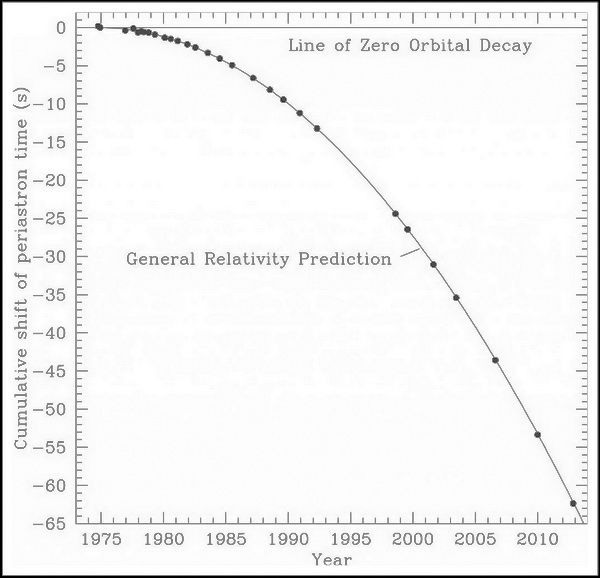
[….]
The most potent of the space-time theorems, the one proven by Arvind Borde, Alexander Vilenkin, and Alan Guth, states that all cosmological models are subject to an initial space-time singularity, regardless of assumptions about homogeneity, isotropy (or lack thereof), or energy conditions, including cosmological models that invoke an early hyper-inflation event.9 This beginning of space and time implies that an Agent operating from beyond space and time must have caused the universe to exist.
About a year after the publication of the theorem, Alexander Vilenkin wrote in a book, “With the proof now in place, cosmologists can no longer hide behind the possibility of a past eternal universe. There is no escape, they have to face the problem of a cosmic beginning.”10 That problem is a causal Agent who transcends space and time. Such a causal Agent matches the description of the God of the Bible.
[1] Joel Weisberg and Yuping Huang, “Relativistic Measurements from Timing the Binary Pulsar PSR B1913+16,” Astrophysical Journal 829 (September 2016): id. 55, doi:10.3847/0004-637X/829/1/55.
[2] Joel Weisberg, David Nice, and Joseph Taylor, “Timing Measurements of the Relativistic Binary Pulsar PSR B1913+16,” Astrophysical Journal 722 (September 2010): 1030–34,doi:10.1088/0004-637X/722/2/1030.
[….]
[10] Alexander Vilenkin, Many Worlds in One: The Search for Other Universes (New York: Hill & Wang, 2007), 176.
- RPT “Editors” Note: for more on Vilenkin, see this post: Dr. William Lane Craig Discusses the Borde-Guth-Vilenkin Theorem
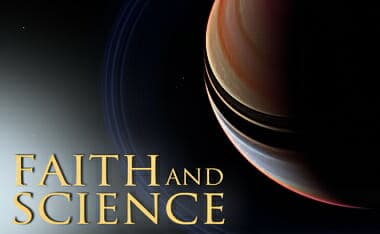
Does Science Make Faith Obsolete? (Spinal Cord Update)
Here is a “graphene” UPDATE STORY on where the technology/advancement has come and is headed.
THE VERGE catches us up with the story, but, they also have a story on a device already using graphene:
….At the end of an event where two devices were already announced — the Huawei Mate 20and Mate 20 Pro — Huawei had another surprise up its sleeve. The Huawei Mate 20 X is the largest in the lineup with its 7.2-inch OLED display, which already consists of three phablet devices. The device is equipped with a massive 5,000mAh battery, and it’s compatible with styluses.
Huawei emphasized the device’s gaming performance and its vapor chamber cooling design that, combined with “graphene film cooling technology,” the company claims will keep its Kirin 980 SoC cool even under heavy loads. Other specs include 6GB of RAM and 128GB of onboard storage, and a dual speaker configuration….
(The below was originally posted in April of 2015)
[Editors note: GRAPHENE is the future of tech (see videos below as well)… way less energy used, faster, stronger, plentiful supply] Here is Dr. Tour’s bio:
James M. Tour is a synthetic organic chemist, specializing in nanotechnology. Dr. Tour is the T. T. and W. F. Chao Professor of Chemistry, Professor of Materials Science and NanoEngineering, and Professor of Computer Science at Rice University in Houston, Texas, United States.
He is well known for his work in molecular electronics and molecular switching molecules. He has also been involved in other work, such as the creation of a nanocar and NanoKids, an interactive learning DVD to teach children fundamentals of chemistry and physics, SciRave, Dance Dance revolution and Guitar Hero packages to teach science concepts to middle-school students and SciRave-STEM for elementary school children, and much work on carbon nanotubes and graphene. Dr. Tour’s work on carbon materials chemistry is broad and encompasses fullerene purification, composites, conductive inks for radio frequencies identification tags, carbon nanoreporters for identifying oil downhole, graphene synthesis from cookies and insects, graphitic electronic devices, carbon particle drug delivery for treatment of traumatic brain injury, the merging of 2D graphene with 1D nanotubes to make a conjoined hybrid material, a new graphene-nanotube 2D material called rebar graphene, graphene quantum dots from coal, gas barrier composites, graphene nanoribbon deicing films, supercapacitors and battery device structures, and water splitting to H2 and O2 using metal chalcogenides. His work with the synthesis of graphene oxide, its mechanism of formation, and its use in capturing radionuclides from water is extensive. Dr. Tour has developed oxide based electronic memories that can also be transparent and built onto flexible substrates. More recently, he has been using porous metal structures to make renewable energy devices including batteries and supercapacitors, as well as electronic memories. Tour is also well known for his work on nanocars, single-molecule vehicles with four independently rotating wheels, axles, and light-activated motors. His early independent career focused upon the synthesis of conjugated polymers and precise oligomers. Dr. Tour was also a founder of the Molecular Electronics Corporation. He holds joint appointments in the departments of chemistry, computer science, and materials science and nanoengineering at Rice University. Dr. Tour received degrees from Syracuse University (BS, 1981), Purdue University (PhD, 1986) and completed postdoctoral work at the University of Wisconsin–Madison (1986–1987) and Stanford University (1987–1988).
Tour holds more than 60 United States patents plus many non-US patents. He has more than 500 research publications.
In the Scientific American article “Better Killing Through Chemistry”, which appeared a few months after the September 11 attacks, Tour is credited for highlighting the issue of the ease of obtaining chemical weapon precursors in the United States.
In 2001, Tour signed the Discovery Institute’s “A Scientific Dissent From Darwinism”, a controversial petition which the intelligent design movement uses to promote intelligent design by attempting to cast doubt on evolution. To those who “are disconcerted or even angered that I signed a statement back in 2001” he responded “I have been labeled as an Intelligent Design (ID) proponent. I am not. I do not know how to use science to prove intelligent design although some others might. I am sympathetic to the arguments on the matter and I find some of them intriguing, but the scientific proof is not there, in my opinion. So I prefer to be free of that ID label.”
He had also said that he felt the explanations offered by evolution are incomplete, and he found it hard to believe that nature can produce the machinery of cells through random processes. On his website, he writes that “From what I can see, microevolution is a fact” and “there is no argument regarding microevolution. The core of the debate for me, therefore, is the extrapolation of microevolution to macroevolution.”
In Lee Strobel’s book “The Case For Faith” – the following commentary is attributed to Tour: “I build molecules for a living, I can’t begin to tell you how difficult that job is. I stand in awe of God because of what he has done through his creation. Only a rookie who knows nothing about science would say science takes away from faith. If you really study science, it will bring you closer to God.”…
(WIKI)
Here is a quote I found fascinating regarding possible spinal injury help via GRAPHINE:
- Eric Metaxes, Is Atheism Dead (Washington, D.C.: Salem Books, 2021), 99.
… in 2013 R&D Magazine named him “Top Scientist of the Year.” He holds joint appointments in the departments of chemistry, computer science, materials science, and nanoengineering, and he has more than 700 research publications and over 140 patents. It is hard to overstate his stature in the field of nanoscience, which includes nanobiology, nanochemistry, and nanoengineering.
Tour is Jewish, born in Manhattan and grew up in the New York area, so when he visited New York City, we met at the Second Avenue Deli in Manhattan.6 Just before our matzo ball soup arrived he thrust his phone at me unannounced and clicked on the unappetizing video of a white rat whose spinal column had been purposely “severed at the C5 vertebrae” so that it was paralyzed from the neck down. He explained to me that using graphene “nanotubes”—bisected lengthwise into what look like noodles, albeit on an impossibly microscopic scale—he has created tiny “bridges” over which nerves can and actually do regrow. As I watched the video I soon saw the same rat utterly restored. Tour explained that in less than two weeks the nerves from opposite sides of the severed vertebrae grew over the graphene and linked, enabling the rodent to control its limbs again. It seemed a miracle, but Tour said similar technology will make it possible to reconnect severed optic nerves too, so in lectures he says he is enabling the lame to walk and the blind to see, and even though this gets a laugh, he’s not kidding.
A list of Tour’s other projects—one may consult Wikipedia—is impossibly long and impressive. It includes creating “nanocars,” each of which is comprised of a single molecule. His 2005 article about this—titled “Directional Control in Thermally Driven Single-Molecule Nanocars”—was ranked the Most Accessed Journal Article by the American Chemical Society. These are molecules he creates in the lab that are essentially tiny cars with independently moving axles, wheels, and a chassis. And each of them has a “motor” fueled by light. This is not science fiction, but science. Tour explains that if thirty thousand or so of these molecular “cars” were parked side by side, they would take up the width of a human hair…..

The Cost of Materialism (Nihilism)
Hat-tip to EVOLUTION NEWS & SCIENCE TODAY for this.
The role played by the Judeo-Christian tradition in the rise of Western science is a contentious topic — but not an obviously emotional one. Or so you might think. Stephen Meyer spoke on the subject at our most recent Dallas Conference on Science and Faith. The video is up now. In a new presentation using the story of Isaac Newton and his investigation of the nature of gravitation as a case study, Meyer recalls an earlier talk he gave at the Dallas Conference on related themes where a young woman, a member of the video crew, broke down in tears as Steve spoke. She later confessed in a communication to us:
Throughout my college career, professors would constantly lecture that based on the evidence they had provided…there should be no way that anyone in the class could believe in God. They’d argue that the science was proven… and God was hence a myth. I was not equipped to present a valid opposition in a debate. I was desperate to find a commonality between my beliefs and my [scientific] education. [Emphasis added.]
“Desperate” is a remarkable word. How many young people are being educated to believe that thinking scientifically means discarding a relationship with God?
[….]
As these comments suggest, the nihilism that is being sown by materialism is not just an intellectual problem. The desperation that goes with it cuts to the heart of many people. If you have children in college, as I do, it’s a very scary thing. Many thanks to Steve Meyer for tackling the science-versus-faith “warfare” myth directly. One viewer notes that he sent the lecture to his “agnostic brother” who is “really into the sciences.” Good idea.
Bestselling author Stephen Meyer explores how three key Judeo-Christian presuppositions encouraged the rise of modern science, and he explores the influence of faith on the life and work of Sir Isaac Newton. Meyer is Director of the Center for Science and Culture at Discovery Institute and author of Return of the God Hypothesis. This talk was presented at the 2022 Dallas Conference on Science and Faith in January 2022.
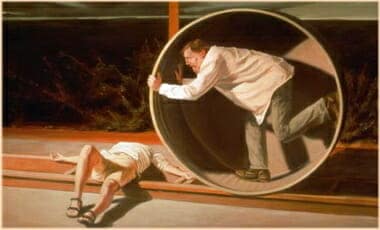
5-Part Series: Science and God | Stephen Meyer
Can you believe in God and science at the same time? Many claim that belief in religion is at odds with “the science” of today. But is that really true? In this five-part series, Stephen Meyer, Senior Fellow at the Discovery Institute, attempts to answer this existential question.
Series “Broken Out”
- Are Religion and Science in Conflict? — Science and God | Does belief in God get in the way of science? The idea that science and religion are inevitably in conflict is a popular way of thinking today. But the history of science tells a different story.
- How Did the Universe Begin? — Science and God | Was the universe always here, or did it have a beginning? If so, how did it start? Mankind has debated these questions for centuries and has only recently begun to find some answers. And those answers may point to some even more intriguing conclusions.
- Aliens, the Multiverse, or God? — Science and God | Even staunch Darwinists have acknowledged that life in the universe displays an appearance of design, rather than being created out of random chance. If that’s true, where did that design come from? In other words, does a design require a designer?
- What Is Intelligent Design? — Science and God | Chances are if you’ve heard anything about intelligent design, you’ve heard that it’s faith-based, not science-based. Is that true? Or does modern science, in fact, point us in the direction of a designing intelligence?
- What’s Wrong with Atheism? — Science and God | Is there any meaning to life? Or is life nothing more than a cosmic accident? Scientific atheists claim the latter, but ironically, it’s science itself that suggests the former.
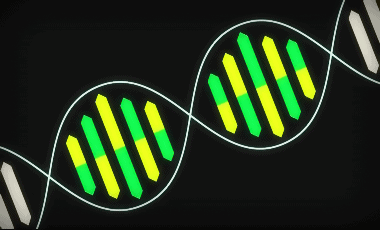
The Naturalistic Origin Of Life (RNA World Critiqued)
The Origin of Life, two world views, Darwinian evolution theory vs Biblical Creation.
The RNA World Hypothesis is presented in the first half of this video from Dr. Pierre Durand, University of the Witwatersrand, Johannesburg. PhD student Nisha Dhar Quote (Via TImes Live):
- ‘RNA molecules were the first molecules which could have given rise to life.’
- ‘This event is believed to have taken place possibly 4 billion years ago, at a time when a young earth was a hostile place with a volcanic activity and an atmosphere that had yet to contain oxygen. RNA, said Durand, was hardy and would have survived these kinds of conditions.’
Presenting the Biblical Creation science explanation for the origin of life, Dr. James M. Tour (PhD., T. T., and W. F. Chao Professor of Chemistry Professor of Computer Science Professor of Materials Science and Nano Engineering — Rice University. Smalley-Curl Institute and the NanoCarbon Center.)
APOLOGETIC PRESS notes this of the RNA World Hypothesis:
- [Editor’s Note: The following article was written by A.P. auxiliary staff scientist Will Brooks and one of his students. Dr. Brooks holds a Ph.D. in Cell Biology from the University of Alabama at Birmingham and serves as Assistant Professor of Biology at Freed-Hardeman University.]
….Evolutionists would have us to believe that non-living elements and molecules joined together and developed increasing biological capabilities. Those who believe in intelligent design reject this hypothesis, insisting that neither RNA nor living cells are able to evolve spontaneously. While some disagreement exists among those in the evolutionary community on the time frame for such alleged reactions to occur, the consensus is that, given large amounts of time, single-celled bacteria were formed. But all known biological principles militate against this notion. Even billions of years could not provide mechanisms for the reaction products to evolve advantageous characteristics and form DNA and cell proteins, let alone create strings of RNA nucleotides, arriving at just the right sequence in order to code for a functional protein. The four nucleotide bases that form RNA (adenine, guanine, cytosine, and uracil) can be arranged in an exponential array of combinations and lengths. For an actual, functional protein to be coded, a precise sequence of nucleotides must be obtained. Forming the code for even one protein by evolutionary means is impossible, without even considering the necessity of the number that work together in a single cell.
There is no scientific evidence to suggest that RNA is spontaneously being created and capable of forming pre-cellular life today. While some artificial ribozymes have been created in the laboratory (reviewed in Chen, et al., 2007), there are still significant holes in reproducing an RNA world to support the hypothesis. The ribozymes created artificially lack the abilities to sufficiently process themselves, and there is no evidence of them producing large quantities of advantageous nucleotide sequences. Moreover, no system has ever created cellular life. There is even significant debate among scientists over the conditions and constituents of a “prebiotic Earth” model.
The RNA World Hypothesis is simply another attempt by scientists to explain the origin of life to the exclusion of the divine Creator. Given the absolute impossibility of life originating from the reactions of non-living matter, it can be justified that RNA did not predate other biological molecules. All biological molecules were created together to work in concert. RNA was designed to be the essential intermediate between DNA and proteins, making our cells capable of sustaining life as it was created. The designer of this system must be the intelligent Designer, the God of the Bible.
FOLLOW UP ARTICLES
- About That RNA World Hypothesis (EVOLUTION NEWS & SCIENCE TODAY)
- Evolutionist Criticisms Of The RNA World Conjecture (CREATION.COM)
- The RNA World: A Critique (ORIGINS & DESIGN 17:1)
- The RNA World Hypothesis: The Worst Theory Of The Early Evolution Of Life (except for all the others) (US NATIONAL LIBRARY OF MEDICINE
NATIONAL INSTITUTES OF HEALTH)

Carl Jackson Fills In For Dennis Prager (Larry Elder Interview)

Ghost In The Machine – Richard Milton
This is chapter 15 (The Ghost In The Machine) from Richard Milton excellent book entitled, “SHATTERING THE MYTHS OF DARWINISM” (PDF), as well as a bit from near the end of the book regarding a “spellchecking” program to shore up his ideas from chapter fifteen. It really has to do with responding to the idea that a computer program is shown to “evolve.” That in some way there is an increase in novel information in the program that is adding to the specificity of the program apart from the designers/software engineers.
I would be remiss to not link to an article that also goes through this example well:
- Weasel, A Flexible Program For Investigating Deterministic Computer “Demonstrations” Of Evolution (Creation.com)
- Dawkins’ Weasel Revisited (Creation.com)
- Evolution Program (Creation Wiki)
- Weasel Words: Refuting A Common Ploy To Persuade People That Evolution Has Been “Proven By Computer” (Creation.com)
Enjoy… mind you this book was read by me in 1998, but the ideas here have been sustained through today.
Ghost in the Machine
pp. 167-176
[167>] Russel and Seguin’s 1982 picture of a human-looking “evolved” version of a dinosaur was an impressive feat combining science and imagination in a constructive and entertaining way. Yet few in 1982 foresaw that in little more than a decade, over 100 million people around the world would pay to be scared by the even more impressive feat of the computer generated dinosaurs of “Jurassic Park”.
Nothing that has entered the evolution debate since Darwin’s time has promised to illuminate the subject so much as the modern computer and its apparently limitless ability to represent, on the monitor-screen, compelling visual solutions to the most abstruse mathematical questions.
The information handling capacity of electronic data processing, with its obvious analogy to DNA, has been enthusiastically enlisted by computer-literate Darwinists as offering powerful evidence for their theory; while genetic software systems, said to emulate the processes of genetic mutation and natural selection at speeds high enough to make the process visible, have become a feature of most up-to-date biology laboratories.
The computer has been put to many ingenious uses in the service of Darwinist theory. And it has changed the minds of not a few skeptics by its powerful visual imagery and uncanny ability to bring extinct creatures – or even creatures that never lived – to life in front [168>] of us. But, compelling though the visual images are, how much confidence should we put in the computer as a guide to the evolution of life?
In his book The Blind Watchmaker Richard Dawkins describes a computer program he wrote which randomly generates symmetrical figures from dots and lines. These figures, to a human eye, have a resemblance to a variety of objects. Dawkins gives some of them insect and animal names, such as bat, spider, fox or caddis fly. Others he gives names like lunar lander, precision balance, spitfire, lamp and crossed sabers.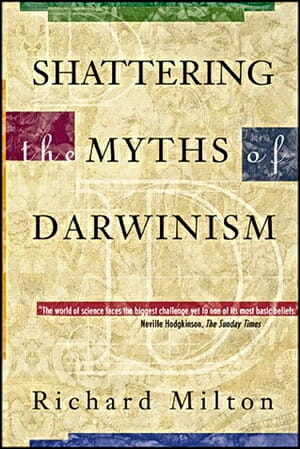
Dawkins calls these creations “biomorphs”, meaning life shapes or living shapes, a term he borrows from fellow zoologist Desmond Morris. He also feels very strongly that in using a computer program to create them, he is in some way simulating evolution itself. His approach can be understood from this extract:
Nothing in my biologist’s intuition, nothing in my 20 years experience of programming computers, and nothing in my wildest dreams, prepared me for what actually emerged on the screen. I can’t remember exactly when in the sequence it first began to dawn on me that an evolved resemblance to something like an insect was possible. With a wild surmise, I began to breed generation after generation, from whichever child looked most like an insect. My incredulity grew in parallel with the evolving resemblance…. Admittedly they have eight legs like a spider, instead of six like an insect, but even so! I still cannot conceal from you my feeling of exultation as I first watched these exquisite creatures emerging before my eyes.[1]
Dawkins not only calls his computer drawings “biomorphs”, he gives some of them the names of living creatures. He also refers to them as “quasi-biological” forms and in a moment of excitement calls them “exquisite creatures”. He plainly believes that in some way they correspond to the real world of living animals and insects. But they do not correspond in any way at all with living things, except in the purely trivial way that he sees some resemblance in their shapes. The only thing about the “biomorphs” that is [169>] biological is Richard Dawkins, their creator. As far as the “spitfire” and the “lunar lander” are concerned there is not even a fancied biological resemblance.
The program he wrote and the computer he used have no analog at all in the real biological world. Indeed, if he set out to create an experiment that simulates evolution, he has only succeeded in making one that simulates special creation, with himself in the omnipotent role.
His program is not a true representation of random mutation coupled with natural selection. On the contrary it is dependent on artificial selection in which he controls he sees some resemblance in their shapes. The only thing about the “biomorphs” that is biological is Richard Dawkins, their creator. As far as the “spitfire” and the “lunar lander” are concerned there is not even a fancied biological resemblance.
The program he wrote and the computer he used have no analog at all in the real biological world. Indeed, if he set out to create an experiment that simulates evolution, he has only succeeded in making one that simulates special creation, with himself in the omnipotent role.
His program is not a true representation of random mutation coupled with natural selection. On the contrary it is dependent on artificial selection in which he controls the rate of occurrence of mutations. Despite Dawkins’s own imaginative interpretations, and even with the deck stacked in his favor, his biomorphs show no real novelty arising. There are no cases of bears turning into whales.
There is also no failure in his program: his biomorphs are not subject to fatal consequences of degenerate mutations like real living things. And, most important of all, he chooses which are the lucky individuals to receive the next mutation – it is not decided by fate – and of course he chooses the most promising ones (“I began to breed from whichever child looked most like an insect.”) That is why they have ended up looking like recognizable images from his memory. If his mutations really occurred randomly, as in the real world, Dawkins would still be sitting in front of his screen watching a small dot and waiting for it do something.
Above all, his computer experiment falsifies the most important central claim of mechanistic Darwinian thinking; that, through natural processes, living things could come into being without any precursor. What Dawkins has shown is that, if you want to start the evolutionary ball rolling, you need some form of design to take a hand in the proceedings, just as he himself had to sit down and program his computer.
In fact, his experiment shows very much the same sort of results that field work in biology and zoology has shown for the past hundred years: there is no evidence for beneficial spontaneous genetic mutation; there is no evidence for natural selection (except as an empty tautology); there is no evidence for either as significant evolutionary mechanisms. There is only evidence of an unquenchable optimism among Darwinists that given enough [170>] time, anything can happen – the argument from probability.
But although Dawkins’s program does not qualify as a simulation of random genetic mutation coupled with natural selection, it does highlight at least one very important way in which computer programs resemble genetic processes. Each instruction in a program must be carefully considered by the programmer as to both its immediate effect on the computer hardware and its effects on other parts of the program. The letters and numbers which the programmer uses to write the instructions have to be written down with absolute precision with regard to the vocabulary and syntax of the programming language he uses in order for the computer system to function at all. Even the most trivial error can lead to a complete malfunction. In 1977, for example, an attempt by NASA to launch a weather satellite from Cape Canaveral ended in disaster when the launch vehicle went off course shortly after takeoff and had to be destroyed. Subsequent investigation by NASA engineers found that the accident was caused by failure of the onboard computer guidance system – because a single comma had been misplaced in the guidance program.
Anyone who has programmed a computer to perform the simplest task in the simplest language – Basic for instance – will understand the problem. If you make the simplest error in syntax, misplacing a letter, a punctuation mark or even a space, the program will not run at all.
In just the same way, each nucleotide has to be “written” in precisely the correct order and in precisely the correct location in the DNA molecule for the offspring to remain viable, and, as described earlier, major functional disorders in humans, animals and plants are caused by the loss or displacement of a single DNA molecule, or even a single nucleotide within that molecule.
In order to simulate neo-Darwinist evolution on his computer, it is not necessary for Dawkins to devise complex programs that seek to simulate insect life. All he has to do is to write a program containing a large number of instructions (3000 million instructions if he wishes to simulate human DNA) that continually regenerates its own program code, but randomly interferes with the code in trivial ways, such as transposing, shifting or missing characters. (The system must be set to restart itself after each fatal “birth”.)
[171>] The result of this experiment would be positive if the system ever develops a novel function that was not present in the original programming. One way of defining “novelty” would be to design the program so that, initially, its sole function was to replicate itself (a computer virus). A novel function would then be anything other than mere reproduction. In practice, however, I do not expect the difficulty of defining what constitutes a novelty to pose any problem. It is extremely improbable that Dawkins’s program will ever work again after the first generation, just as in real life, mutations cause genetic defects, not improvements.
Outside of the academic world there are a number of important commercial applications based on computer simulations that deserve to be seriously examined. A good example of this is in the field of aircraft wing design where computers have been used by aircraft engineers to develop the optimum airfoil profile. In the past wing design has been based largely on repetitive trial and error methods. A hypothetical wing shape is drawn up; a physical model is made and is aerodynamically tested in the wind tunnel. Often the results of such an empirical design approach are predictable: lengthening the upper wing curve, in relation to the lower, generally increases the upward thrust obtained. But sometimes results are very unpredictable, as when complex patterns of turbulence combine at the trailing edge to produce drag, which lowers wing efficiency, and causes destructive vibration.
Engineers at Boeing Aircraft tried a new approach. They created a computer model which was able to “mutate” a primitive wing shape at random – to stretch it here or shrink it there. They also fed into the model rules that would enable the computer to simulate testing the resulting design in a computerized version of the “wind tunnel”- the rules of aerodynamics.
The engineers say this process has resulted in obtaining wing designs offering maximum thrust and minimum drag and turbulence, more quickly than before and without any human intervention once the process has been set in motion.
Designers have made great savings in time compared with previous methods and the success of the computer in this field has given rise to a new breed of application dubbed “genetic software”. Indeed, on the face of it, the system is acting in a Darwinian manner. The [172>] computer (an inanimate object) has produced an original and intelligent design (comparable, say, with a natural structure such as a bird’s wing) by random mutation of shape combined with selection according to rules that come from the natural world – the laws of aerodynamics. If the computer can do this in the laboratory in a few hours or days, what could nature not achieve in millions of years?
The fallacies on which this case is constructed are not very profound but they do need to be nailed down. In a recently published popular primer on molecular biology, Andrew Scott’s Vital Principles, this very example is given under the heading “the creativity of evolution”. The process itself is called “computer generated evolution” as though it were analogous to an established natural process of mutation and selection.[2]
The most important fallacy in this argument is the idea that somehow a result has occurred which is independent of, or in some way beyond the engineers, who merely started the machine by pressing a button. Of course, the fact is that a human agency has designed and built the computer and programmed it to perform the task in question. As with the previous experiment, this begs the only important question in evolution theory: could complex structures have arisen spontaneously by random natural processes without any precursor? Like all other computer simulation experiments, this one actually makes a reasonable case for special creation – or some form of vitalist-directed design – because it specifically requires a creator to build the computer and devise and implement the program in the first place.
However, there are other important fallacies too. The only reason that the Boeing engineers are able to take the design produced on paper by their computer and translate that design into an aircraft that flies, is because they are employing an immense body of knowledge – not possessed by the com put er – regarding the properties of materials from which the aircraft will be made and the manufacturing processes that will be used to make it. The computer’s wing is merely an outline on paper, an idea: it is of no more significance to aviation than a wave outline on the beach or a wind outline in the desert. The real wing has to actually fly in the air with real passengers. The decisive events that make that idea into a reality are a long, complex sequence of human operations [173>] and judgments that involve not only the shaping and fastening of metal for wings but also the design and manufacture of airframes and jet engines. These additional complexities are beyond the capacity of the computer, not merely in practice but in principle, because computers cannot even make a cup of coffee, let alone an airliner, without being instructed every step of the way.
In order for a physical structure like an aircraft wing to evolve by spontaneous random means, it is necessary for natural selection to do far more than select an optimum shape. It must also select the correct materials, the correct manufacturing methods (to avoid failure in service) and the correct method of integrating the new structure into its host creature. These operations involve genetic engineering principles which are presently unknown. And because they are unknown by us, they cannot be programmed into a computer.
There is also an important practical reason why the computer simulation is not relevant to synthetic evolution: because an aircraft wing differs from a natural wing in a fundamental way. The aircraft wing is passive, since the forward movement of the aircraft is derived from an engine. A natural wing like a bird’s, however, has to provide upthrust and the forward motion necessary to generate that lift making it a complex, articulated active mechanism. The engineering design problem of evolving a passive wing is merely a repetitive mechanical task – that is why it is suitable for computerization. So far, no-one has suggested programming a computer to design a bird’s wing by random mutation because the suggestion would be seen as ludicrous. Even if all of the world’s computers were harnessed together, they would be unable to take even the most elementary steps needed to design a bird’s wing unless they were told in advance what they were aiming at and how to get there.
If computers are no use to evolutionists as models of the hypothetical selection process, they are proving invaluable in another area of biology; one that seems to hold out much promise to Darwinists – the field of genetics. Since Watson and Crick elucidated the structure of the DNA molecule, and since geneticists began unraveling the meaning of the genetic code, the center of gravity of evolution theory has gradually shifted away from the earth sciences – geology and pale-ontology – toward molecular biology.
[174>] This shift in emphasis has occurred not only because of the attraction of the new biology as holding the answers to many puzzling questions, but also because the traditional sciences have proved ultimately sterile as a source of decisive evidence. The gaps in the fossil record, the incomplete-ness of the geological strata, and the ambiguity of the evidence from comparative anatomy, ultimately caused Darwinists to give up and look somewhere else for decisive evidence. Thanks to molecular biology and computer science they now have somewhere else to try.
Darwinists seem to have drawn immense comfort from their recent discoveries at the cellular level and beyond, behaving and speaking as though the new discoveries of biology represent a triumphant vindication of their long-held beliefs over the irrational ideas of vitalists. Yet the gulf between what Darwinists claim for molecular biological discoveries and what those discoveries actually show is only too apparent to any objective evaluation.
Consider these remarks by Francis Crick, justly famous as one of the biologists who cracked the genetic code, and equally well known as an ardent supporter of Darwinist evolution. In his 1966 book Molecules and Men, in which he set out to criticize vitalism, Crick asked which of the various molecular biological processes are likely to be the seat of the “vital principle”.[3] “It can hardly be the action of the enzymes,” he says, “because we can easily make this happen in a test tube. Moreover most enzymes act on rather simple organic molecules which we can easily synthesize.”
There is one slight difficulty but Crick easily deals with it; “It is true that at the moment nobody has synthesized an actual enzyme chemically, but we can see no difficulty in doing this in principle, and in fact I would predict quite confidently that it will be done within the next five or ten years.”
A little later, Crick says of mitochondria (important objects in the cell that also contain DNA):
It may be some time before we could easily synthesise such an object, but eventually we feel that there should be no gross difficulty in putting a mitochondrion together from its component parts.
This reservation aside, it looks as if any system of [175>] enzymes could be made to act without invoking any special principles, or without involving material that we could not synthesize in the laboratory. [4]
There is no question that Crick and Watson’s decoding of the DNA molecule is a brilliant achievement and one of the high points of twentieth-century science. But this success seems to me to have led many scientists to expect too much as a result.
Crick’s early confidence that an enzyme would be produced synthetically within five or ten years has not been borne out and biologists are further than ever from achieving such a synthesis. Indeed, reading and rereading the words above with the benefit of hindsight I cannot help but interpret them as saying “we are unable to synthesize any significant part of a cell at present, but this reservation aside, we are able to synthesize any part of the cell.”
Certainly great strides have been made. William Shrive, writing in the McGraw Hill Encyclopedia of Science and Technology, says, “The complete amino acid sequence of several enzymes has been determined by chemical methods. By X-ray crystallographic methods it has even been possible to deduce the exact three-dimensional molecular structure of a few enzymes.”[5] But despite these advances no-one has so far synthesized anything remotely as complex as an enzyme or any other protein molecule.
Such a synthesis was impossible when Crick wrote in 1966 and remains impossible today. It is probably because there is a world of difference between having a neat table that shows the genetic code for all twenty amino acids (Alanine = GCA, Praline = CCA and so on) and knowing how to manufacture a protein. These complex molecules do not simply assemble themselves from a mixture of ingredients like a cup of tea. Something else is needed. What the something else is remains conjectural. If it is chemical it has not been discovered; if it is a process it is an unknown process; if it is a “vital principle” it has not yet been recognized. Whatever the something is, it is presently impossible to build a case either for Darwinism or against vitalism out of what we have learned of the cell and the molecules of which it is composed.
It is easy to see why evolutionists should be so excited about cellular discoveries because the mechanisms they have found appear to [176>] be very simple. But however simple they may seem, as of yet no-one has succeeded in synthesizing any significant original structure from raw materials. We know the code for the building blocks; we don’t know the instructions for building a house with them.
Indeed, the discoveries of biochemistry and molecular biology have raised some rather awkward questions for Darwinists, which they have yet to address satisfactorily. For example, the existence of genetically very simple biological entities, such as viruses, seems to support Darwinist ideas about the origin of life. One can imagine all sorts of primitive life forms and organisms coming into existence in the primeval ocean and it seems only natural that one should find entities that are part way between the living and the nonliving – stepping stones to life as it were. It is only to be expected, says Richard Dawkins, that the simplest form of self-replicating object would merely be that part of the DNA program which says only “copy me”, which is essentially what a virus is.
The problem here is that viruses lack the ability to replicate unless they inhabit a host cell – a fully functioning cell with its own genetic replication mechanisms. So the first virus must have come after the first cell, not before in a satisfyingly Darwinian processes.
But despite minor unresolved problems of this kind Darwinists still have one remaining card to play in support of their theory. It is the strongest card in their hand and the most powerful and decisive evidence in favor of Darwinian evolutionary processes.
[….]
pp. 223-227
[223>] Earlier on I referred to computers and their programs as a fruitful source of comparison with genetic processes since both are concerned with the storage and reliable transmission of large quantities of information. Arguing from analogy is a dangerous practice, but there is one phenome-non connected with computer systems that could be of some importance in understanding biological information processing strategies.
The phenomenon has to do with the computer’s ability to refer to a master list or template and to highlight any exceptions to this master list that it encounters during processing. This “exception reporting” is profoundly important in information processing. For instance, this book was prepared using a word-processing program that has a spelling checker. When invoked, the spell checker reads the typescript of the book and compares each word with its built-in dictionary, highlighting as potential mistakes those it does not recognize. Of course, it will encounter words that are spelled correctly but are not found in a normal dictionary – such as “deoxyribonucleic acid”. But the program is clever enough to allow me to add the novel word to the dictionary, so that the next time it is encountered it will be accepted as correct instead of reported as an exception – as long as I spell it correctly.
In other words, the spelling checker isn’t really a spelling checker. It has no conception of correct spelling. It is merely a mechanism [224>] for reporting exceptions. Using these methods, programmers can get computers to behave in an apparently intelligent or purposeful way when they are really only obeying simple mechanical rules. Not unnaturally, this gives Darwinists much encouragement to believe that life processes may at root be just as simple and mechanical.
In cell biology there are natural chemical properties of complex molecules that lend them-selves to automatic checking and excepting of this kind. For example many molecules are stereospecific – they will attach only to certain other specific molecules and only in special positions. There are also much more complex forms of exception reporting, for instance as part of the brain’s (of if you prefer, the mind’s) cognitive processes: as when we see and recognize a single face in the crowd or hear our name mentioned at a noisy cocktail party.
In the case of the spelling checker, the behavior of the system can be made to look more and more intelligent through a process of learning if, every time it highlights a new word, I add that word to its internal dictionary. If I continue for a long enough time, then eventually, in principle, the system will have recorded every word in the English language and will highlight only words that are indeed misspelled. It will have achieved the near-miraculous levels of efficiency and repeatability that we are used to seeing in molecular biological processes. But something strange has also been happening at the same time – or, rather, two strange things.
The first is that as its vocabulary grows, the spelling checker becomes less efficient at drawing to my attention possible mistakes. This unexpected result comes about in the fallowing way. Remember, the computer knows nothing of spelling, it merely reports exceptions to me. To begin with, it has only, say, 50,000 standard words in its dictionary. This size of dictionary really only covers the common everyday words plus a modest number of proper nouns (for capital cities, common surnames and the like) and doesn’t leave much room for unusual words. It would, for instance include a word like ‘great’ but not the less-frequently used word “grate”.
The result is that if I accidentally type “grate” when I really mean “great”, the spell checker will draw it to my attention. If however, I enlarge the dictionary and add the word “grate”, the spell [225>]checker will ignore it in future, even though the chances are that it will occur only as a typing mis take – except in the rare case where I am writing about coal fires or cookery.
One can generalize this case by saying that when the dictionary has an optimum size of vo-cabulary, I get the best of both worlds: it points out misspellings of the most common words and reports anything unusual which in most cases probably will be an error. (Obviously to work at optimum efficiency the size of dictionary should be matched to the vocabulary of the writer). As the dictionary grows in volume it becomes more efficient in one way, highlighting only real spelling errors, but less efficient in another: it becomes more probable that my typing errors will spell a real word – one that will not be reported – but not the word I mean to use. Paradoxically, although the spelling checker is more efficient, the resulting book is full of contextual errors: ‘pubic’ instead of ‘public’, ‘grate’ instead of ‘great’ and so on.
It requires a human intelligence -a real spelling checker, not a mechanical exception reporter to make sure that the intended result is produced.
I said two strange things have been happening while I have been adding words to the spelling checker. The second is the odd occasion when the system has highlighted a real spelling mistake to me- say, “problem” instead of “problem” – and I have mistakenly told the computer to add the word to its dictionary. This, of course, has the very unfortunate result that in future it will cease to highlight a real spelling mistake and will pass it as correct. The error is no longer an exception it is now a dictionary word.
Under what circumstances am I most likely to issue such a wrong instruction? It is most likely to happen with words that I type most frequently and that I habitually mistype. Anyone who uses a keyboard every day knows that there are many such ‘favorite’ misspelled words that get typed over and over. Once again, only a real spelling checker, a human brain, can spot the error and correct it.
The reason that the computer’s spellchecker breaks down under these circumstances is that the simple mechanisms put in place do not work from first principles. They do not work in what electronics engineers call ‘real time’ (they are not in touch with the real world) and do not employ any real intelligent understanding [226>] of the tasks they are being called on to perform. So although the computer continues to work perfectly as it was designed to, it becomes more and more corrupted from the standpoint of its original function.
I believe that this analogy may well have some relevance to Darwinists’ belief that biological processes can at root be as simple as the spelling checker. It is easy to think of any number of simple cell replication mechanisms that rely on exception reporting of this kind. I believe that if biological processes were so simple, they too would become functionally corrupt unless there is some underlying or overall design process to which the simple mechanisms answer globally, and which is capable of taking action to correct mistakes. This is the mechanism that we see in action in the case of the “eyeless fly”, Drosophila; in Driesch’s experiment with the sea urchin and Balinsky’s with the eyes of amphibians; the ‘field’ that governs the metamorphosis of the butterfly or the reconstitution of the cells of sponges and vertebrates.
Darwinists believe that the only overall control process is natural selection, but the natural selection mechanism could not account for the cases referred to above. Natural selection works on populations, not individuals. It is capable only of tending to make creatures with massively fatal genetic defects die in infancy, or to make populations that are geographically dispersed eventually produce sterile hybrid offspring. It is such a poor feedback mechanism in the sense of exercising an overall regulating effect that it has failed even to eliminate major congenital diseases. Natural selection offers only death or glory: there is no genetic engineering nor holistic supervision of the organism’s integrity. Yet we are asked to believe that a mechanism of such crudity can creatively supervise a program of gene mutation that will restore sight to the eyeless fly.
This is plainly wishful thinking. The key question remains: what is the location of the supervisory agency that oversees somatic development? How does it work? What is it’s connection with the cell structure of the body?
FOOTNOTES
- Richard Milton, Shattering the Myths of Darwinism (Rochester, VT: Park Street Press, 1997), 167-176; 223-226.
(Editor’s Note. The author did not footnote what page he was quoting from, he only cited the work itself)
[1] Richard Dawkins, The Blind Watchmaker (London, England: Pearson Longman, 1986).
[2] Andrew Scott, Vital Principles: The Molecular Mechanisms of Life (Oxford, England: Blackwell Publishers, 1988).
[3] Francis Crick, Of Molecules and Men (Seattle, WA: Univ of Washington Press, 1966).
[4] Ibid.
[5] William Shrive, Enymes, in the McGraw-Hill Encyclopedia of Science & Technology (New York, NY: McGraw-Hill Book Company, 1982).

An Empty Attack On Faith: “Scientists Read More”
I was cruisin, the WWW (in this case, a group on Facebook)… and I came across this “blurb (picture to the right).  Now, I do not post this to “brag,” but I post this as a confirmed bibliophile and someone who plans on an eternity of learning truth.
Now, I do not post this to “brag,” but I post this as a confirmed bibliophile and someone who plans on an eternity of learning truth.
Here is a blurb from my bio:
I have interests, and most of them pertain to reading and learning as a hobby. My home library is well over 5,000 books (politics, religions, philosophy, economics, environment, history, origins, apologetics, etc… all non-fiction stuff my wife h-a-t-e-s), and about 600 DVDs dealing with much of the same (a lot of formal debates are in this collection). (A partial tour is in the video below [low-rez 2005].)
- This is a recovery from my Vimeo account and was made with a low-rez camera in 2005 as a package to help my admission into a seminary. One day I will run through my library with the high resolution of today. One day.
I also want to note that while I am posting pics just on two sections of my library, this is repeated in all my categories — like: history, philosophy, world religions, cults, occult, apologetics, politics, civics, current affairs, economics, etc., etc. This first example is of Islam, a sliver of my world religious section (you can click to enlarge if so inclined):
And this is my section related to the reason to this post… note that many works in the collection are textbooks and/or works countering creation and Intelligent design or books by evolutionists on various subject within said paradigm. And yes, that is a pallet of books to the right of my packed-up portion of my library:
— these are two rows of books deep on most shelves —
BOOKS
Here are some of the shelves and books of this section of my library from the picture above (take note as well that I own many of the often quoted and used National Geographic, Nature Journal, Scientific American, and other magazines/journals):
Also, here is some of the atheist/theist debates, creationist/evolutionist debates, etc in DVD:
DVDs

